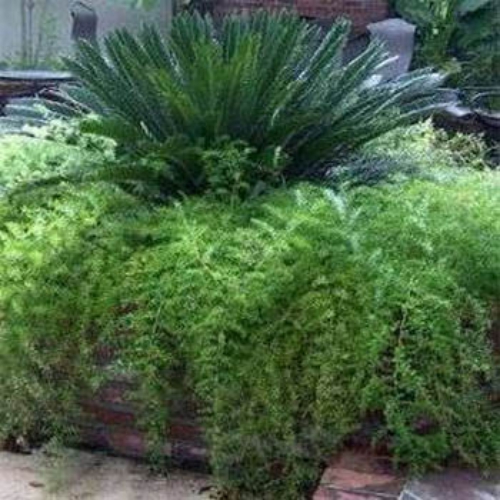New Account | Seed Mix |
Gift Certificates |AAS Winners |
Gardening Products
SEEDS: Unusual | Annuals | Perennials | Vegetables | Herbs | Trees
Annual Plants
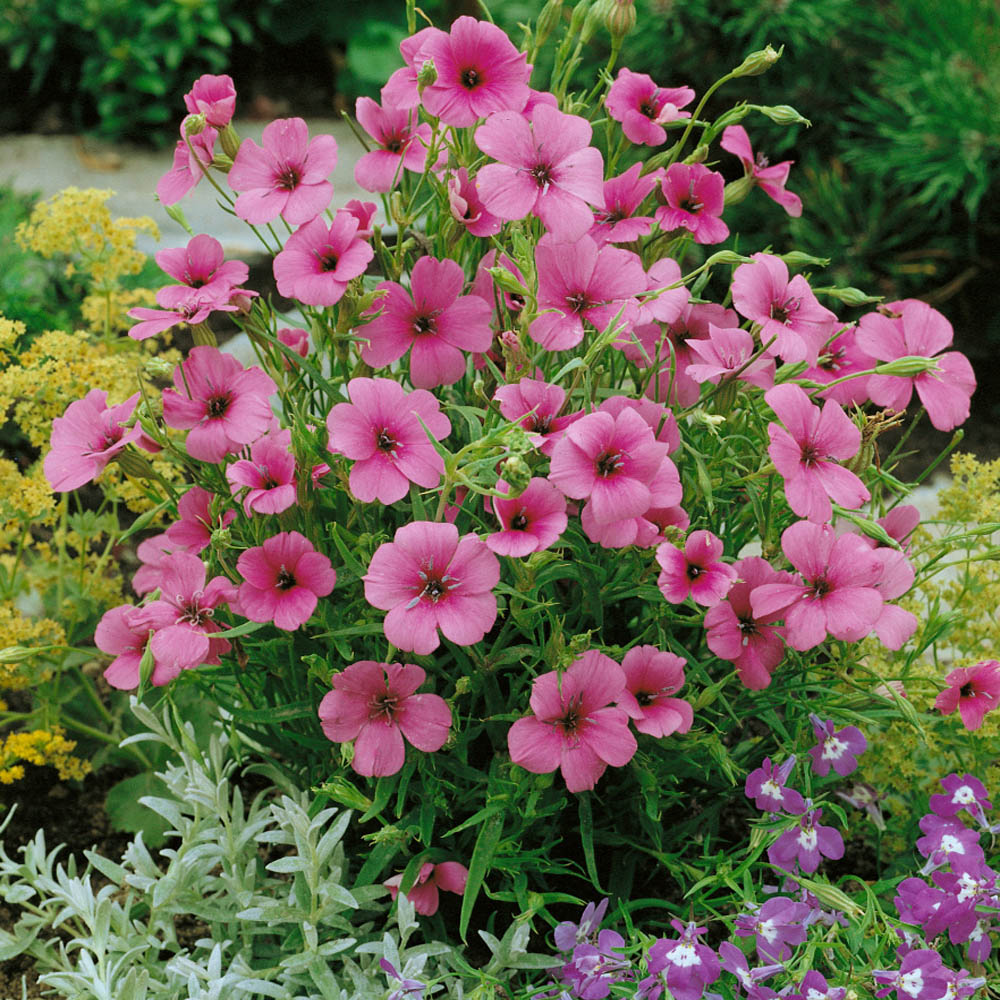
LET742 Rose Angel ( Viscaria Oculata )
Sometimes this annual is called Catchfly or Rose of Heaven. Plant these annuals in mass groupings for a terrific display of color. Viscaria Rose Angel will readily establish from flower seeds, and truly there is no easier plant to grow and to maintain. They are fuss-free beauties, and they will bloom their hearts out for you! They are perfect either in the garden or in containers, and their long stems make them perfect for cutting for the vase.
Catchfly Angel Rose has blooms that measure 2 inches across, with bright rose petals starred with an brilliant magenta eye. The Viscaria plants reach 10 inches in height and the same in width. They are not picky about soil, but it does need to be well-drained. They prefer a sunny location in the garden.
Directly sow Viscaria seeds outdoors in a prepared seedbed. Wait until last frost before planting the Viscaria Oculata seeds. Sow groups of 3-4 seeds and space them 10 inches apart. Thin to strongest plant. Rose Of Heaven Viscaria blooms in 6-8 weeks after sowing.
Catchfly Angel Rose has blooms that measure 2 inches across, with bright rose petals starred with an brilliant magenta eye. The Viscaria plants reach 10 inches in height and the same in width. They are not picky about soil, but it does need to be well-drained. They prefer a sunny location in the garden.
Directly sow Viscaria seeds outdoors in a prepared seedbed. Wait until last frost before planting the Viscaria Oculata seeds. Sow groups of 3-4 seeds and space them 10 inches apart. Thin to strongest plant. Rose Of Heaven Viscaria blooms in 6-8 weeks after sowing.
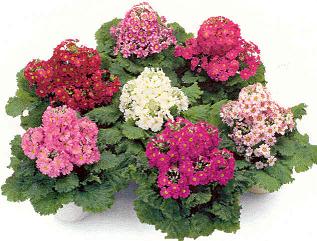
LET705 Primula Special Mix ( Primula malacoides )
Compact plants with dense open flower clusters just above the foliage, rainbow of color.
Sow Primrose seeds indoors in late fall or early winter. Use starter trays and a peaty starter mix.
Grows only 8 inches tall. This Common Primrose (also known as English Primrose) is a flowering annual plant that grows in USDA zones 4 through 8.
Grows only 8 inches tall. This Common Primrose (also known as English Primrose) is a flowering annual plant that grows in USDA zones 4 through 8.
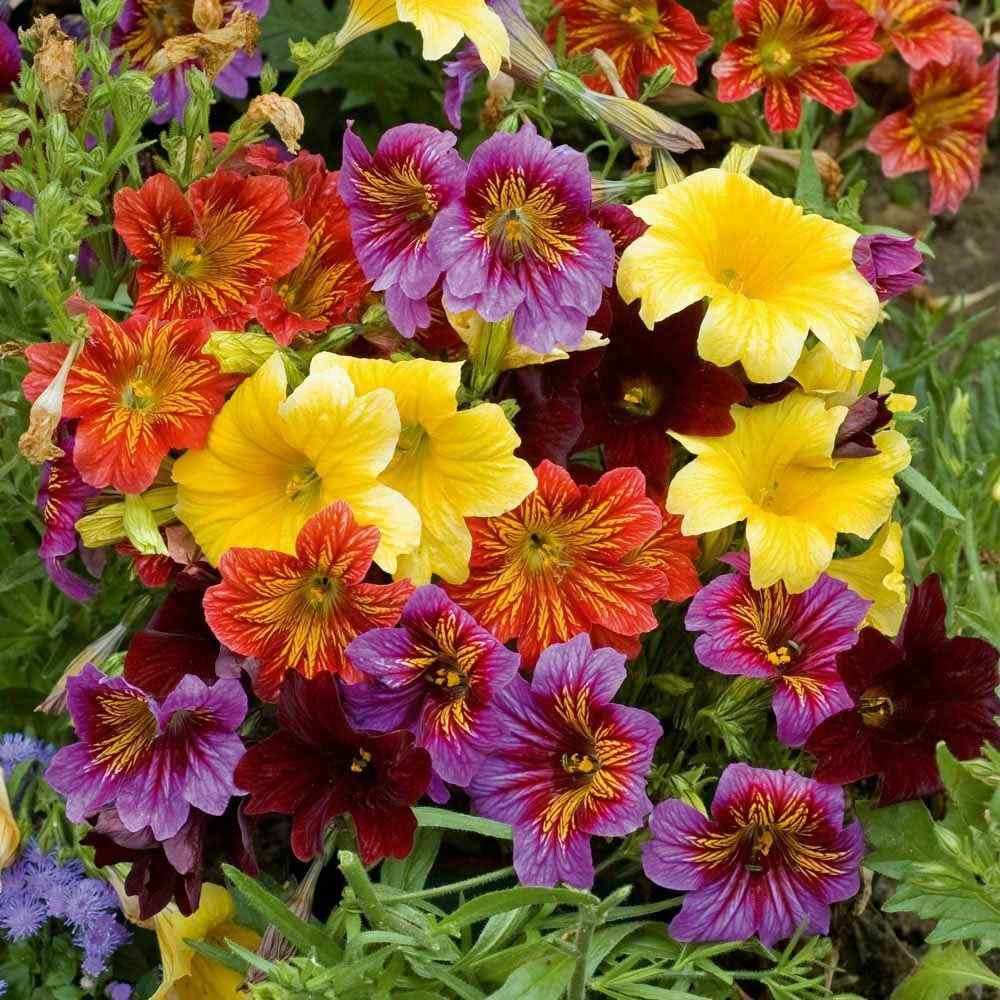
JB121 Painted Tongue ( Salpiglossis Sinuata )
This annual is a native of South America and related to petunias. The Salpiglossis flower is trumpet-shaped and about 2 inches in width, and each flower is rich with velvety color and veins that are painted with a contrasting color. It is perfect for the flower bed or in containers and baskets. The flowers are excellent for cutting and last in the vase nicely.
This South American native loves cool weather and blooms from spring until the plant begins to fade in midsummer. Salpiglossis often produces a late-season burst of color when temperatures drop in autumn. Grows about 16 inches tall, sometimes a bit taller.
This South American native loves cool weather and blooms from spring until the plant begins to fade in midsummer. Salpiglossis often produces a late-season burst of color when temperatures drop in autumn. Grows about 16 inches tall, sometimes a bit taller.
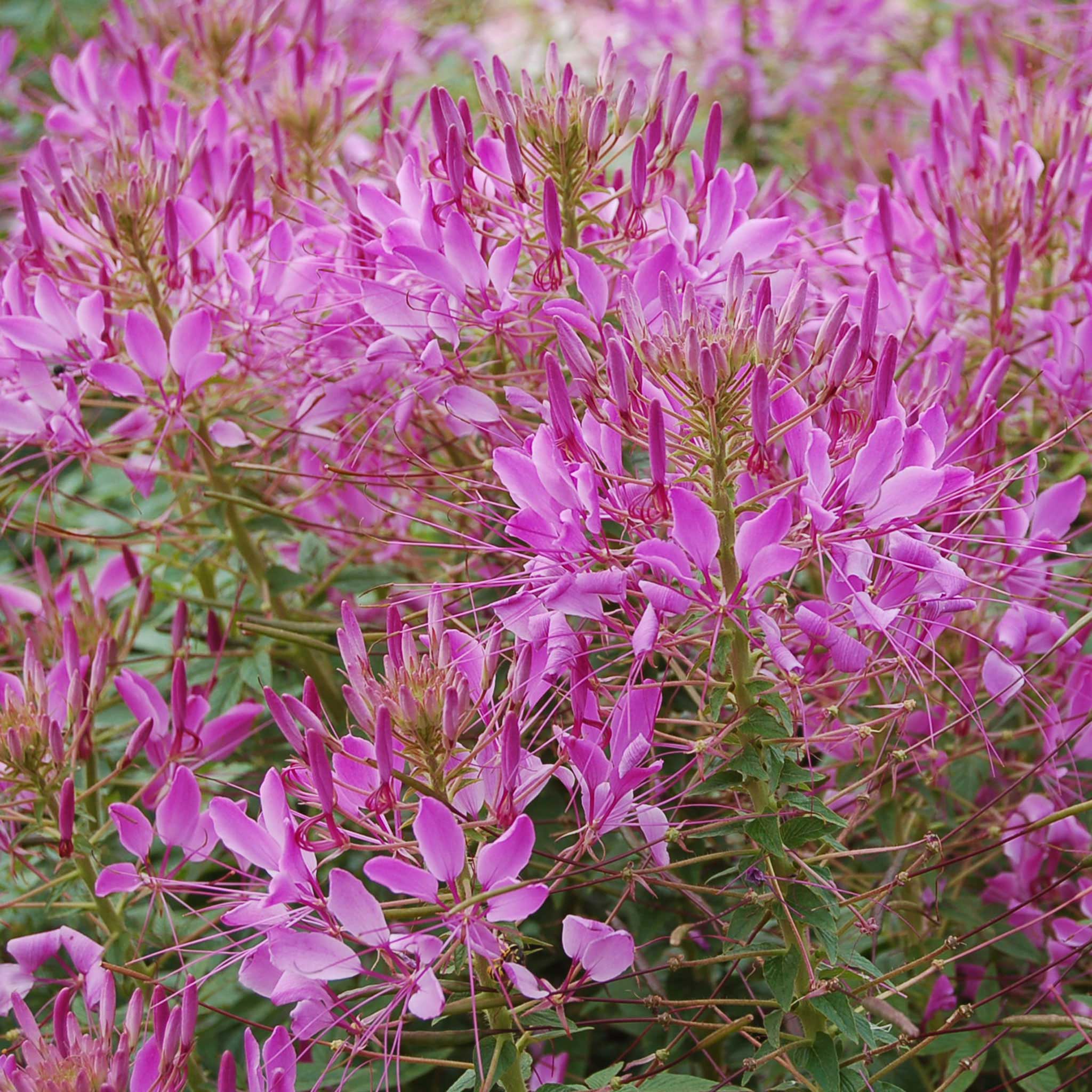
JB278 Mauve Queen Cleome ( Cleome hassleriana )
Hummingbirds love these nectar-rich flowers on this wonderful Spider Plant. Brilliant pink blooms that pollinators love and makes wonderful cutflowers. This beautiful Mauve Pink bloom is sure to be a crowning jewel in your garden, especially if you live in a hot, southern region!
A wonderful cottage garden plant, it mixes well with other tall flowers such as cosmos, snapdragons and zinnias. Attractive to butterflies and hummingbirds cleome requires little care and remains attractive in heat and drought. Resistant to deer and rabbits. Grows 36 inches tall.
A wonderful cottage garden plant, it mixes well with other tall flowers such as cosmos, snapdragons and zinnias. Attractive to butterflies and hummingbirds cleome requires little care and remains attractive in heat and drought. Resistant to deer and rabbits. Grows 36 inches tall.
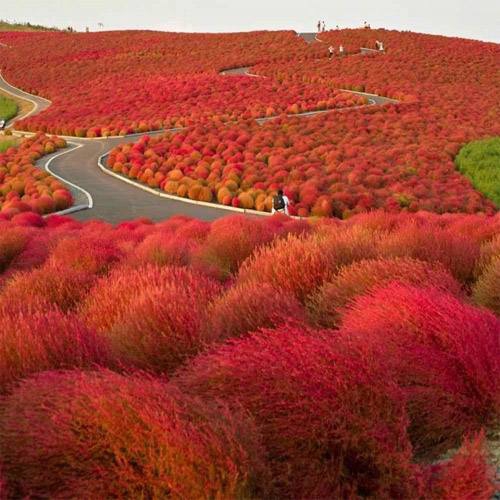
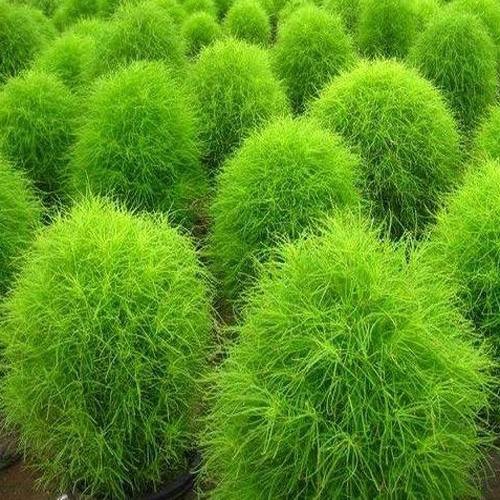
JB159 Burning Bush ( Kochia Trichophylla )
An excellent way to add dramatic color to your flower beds and backgrounds, this feathery bush is pale green in the summer, but then transforms to an intense red in the fall. It is symmetrical and oval in form and makes an outstanding foliage plant. Truly one of a kind and brings a great addition to the flower garden.
It reaches 28 inches in height and looks great when grown as a hedge along the border or in groups of 3 for focal interest. For areas with a long growing season, Kochia Burning Bush seeds can be started directly outdoors in a prepared seed bed. For earlier Kochia plants, start the seeds indoors. Transplant outdoors after danger of frost has passed. Plant in full sun. Annual.
It reaches 28 inches in height and looks great when grown as a hedge along the border or in groups of 3 for focal interest. For areas with a long growing season, Kochia Burning Bush seeds can be started directly outdoors in a prepared seed bed. For earlier Kochia plants, start the seeds indoors. Transplant outdoors after danger of frost has passed. Plant in full sun. Annual.

LET867 Solar Fire ( Ursinia anethoides )
The Ursinia flower is native to South Africa. The flowers are brilliant yellow-orange and daisy-like with 2-1/2 inch blooms. As an annual, Solar Fire seeds establish quickly, the plant blooms heavily for a long display, and the plant re-seeds for another year of color. It's many uses would include hot, sunny borders and rock gardens. The plant prefers well-draining, sandy to gritty soil. Grows about 15 inches tall.
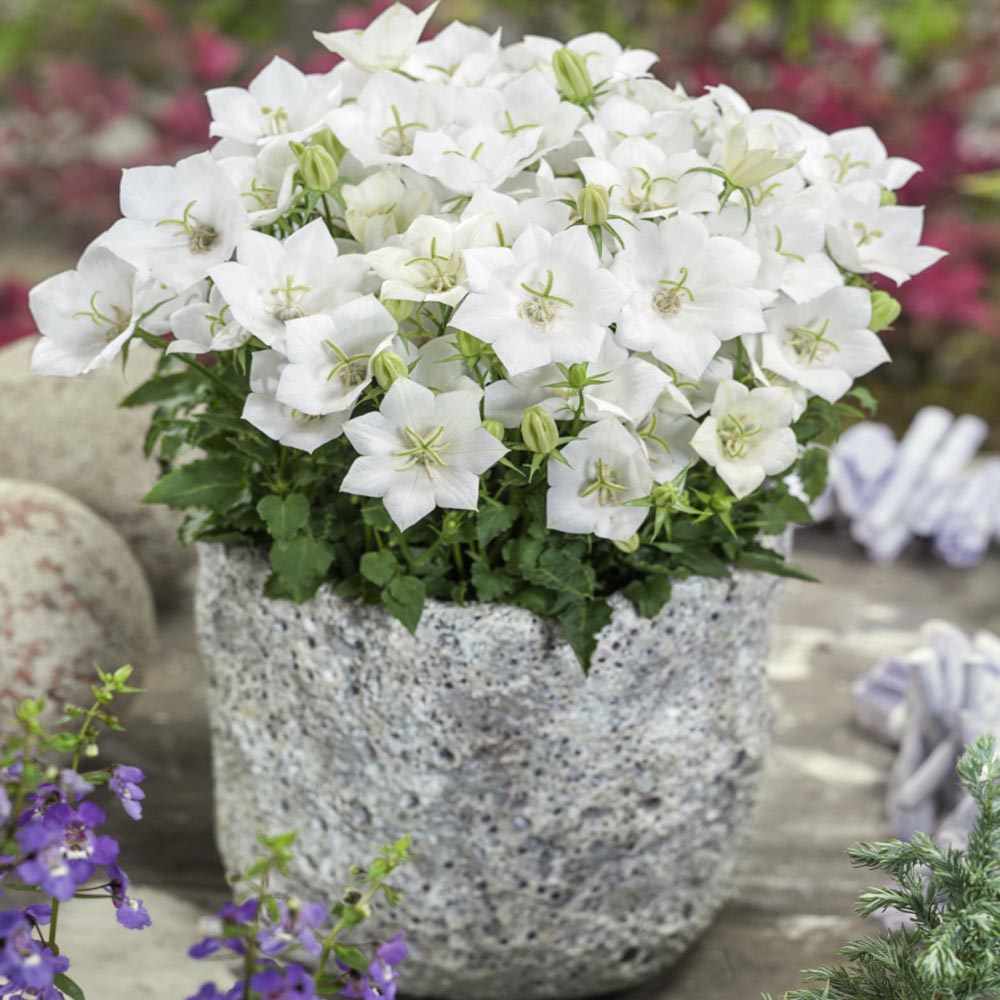
IP029 Carpathian White ( Campanula carpatica )
A campanula growing only 8 inches tall! Deer Resistant. Good for Containers. Easy-to-grow from seed, Campanula carpatica or White Bellflower is easy to establish and always dependable. These lovely white-flowered little plants are gardeners' favorites. Very attractive to hummingbirds! Campanula plants cover their low mounds of foliage with upward-facing white bells for weeks in summer.
A tidy bun of white flowers summer to fall. Low, mounding perennial covered in pure white, bell shaped flowers through the summer. Perfect for low borders, rock gardens or container. Does well in any well drained garden soil. Does well in containers. Good for Cut Flowers. Good for zones 4-8.
A tidy bun of white flowers summer to fall. Low, mounding perennial covered in pure white, bell shaped flowers through the summer. Perfect for low borders, rock gardens or container. Does well in any well drained garden soil. Does well in containers. Good for Cut Flowers. Good for zones 4-8.
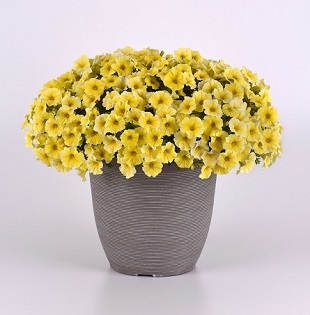
LET769 Petchoa Caliburst Yellow ( Pelleted )
A wonderful new Petunia/Calibrachoa cross that is simply smothered in blooms.
The first petchoa from seed, Caliburst Petchoa is a Petunia sp. x Calibrachoa sp. cross. Petchoa is a hybrid that combines the best characteristics of two popular species: petunias and calibrachoa. Petunia contributes large flower size, excellent vigor, weather resilience, strong roots, pH tolerance, and ease of growth. Calibrachoa provides vibrant flower color and lush, non-sticky foliage, which not only keeps fingers clean but also allows spent blooms to fall cleanly from the plant. But petchoa has better disease resistance and rain, heat, and cold tolerance than both its parents.
It is a tender perennial (Zones 9-11), often grown as an annual, that blooms a full 3 seasons, from early spring through autumn. Free and continuously flowering, this petchoa creates a canopy of color with large, showy, vibrant yellow blooms that are prettily ruffled and long lasting.
Caliburst Yellow Petchoa grows vigorously and has a mounded, spreading but controlled habit. It's perfect in containers, window boxes, and hanging baskets but makes great edging or ground cover in beds and borders. Pelleted seeds for easy handling.
Caliburst Yellow Petchoa grows vigorously and has a mounded, spreading but controlled habit. It's perfect in containers, window boxes, and hanging baskets but makes great edging or ground cover in beds and borders. Pelleted seeds for easy handling.

3061 Shooting Star ( Thymophylla tenuiloba )
Large yellow daisies, teeming with blooms, easy to care for, bred specially for baskets, grows 6" tall. Also known as Dahlberg Daisy, it is a bushy, multi-branching little annual with deeply divided, threadlike leaves. Also known as Golden Fleece, this annual has a profusion of flower heads that measure about 1/2 inch across with bright golden yellow rays and yellow centers. It has a trailing habit, getting 6 - 8 inches high and spreading a little wider. The leaves have a pungent, lemony odor when crushed or bruised. It also makes a great groundcover and bedding plant.
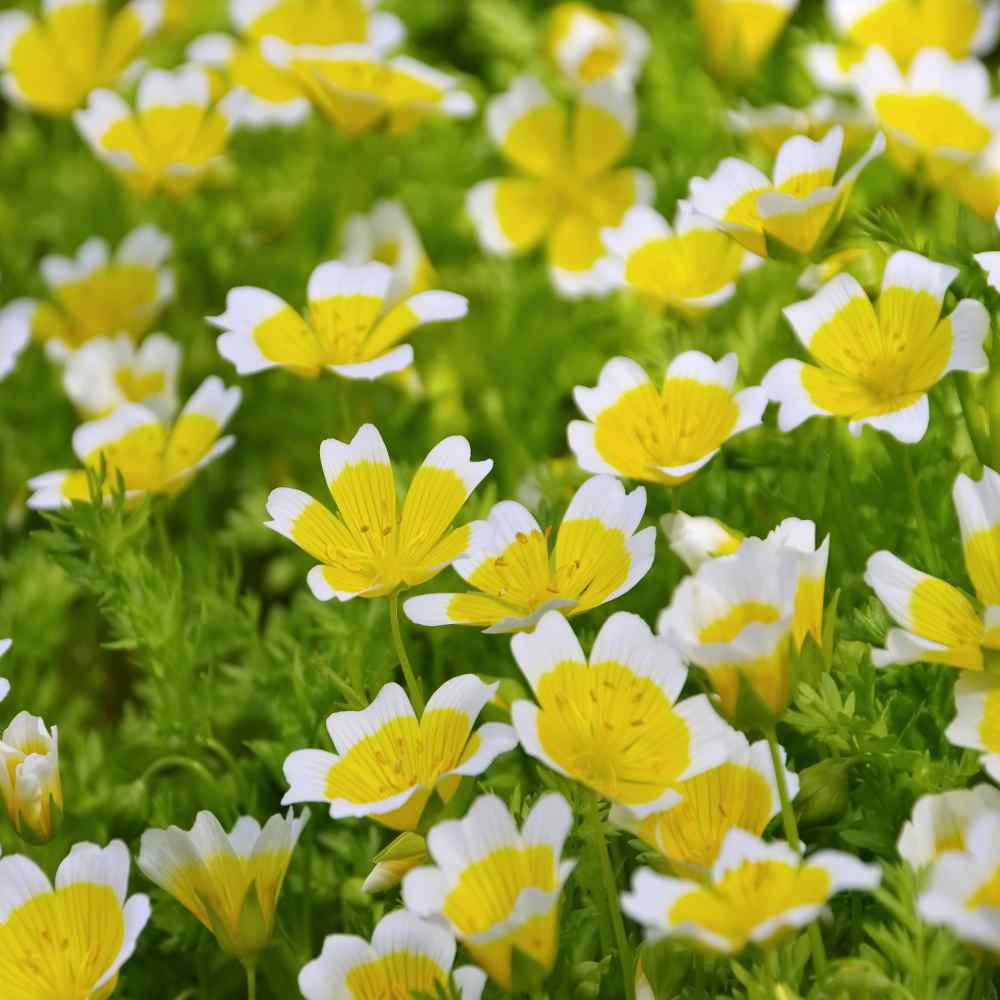
JB160 Poached Egg Plant ( Limnanthes Douglasii )
Also called Meadowfoam, and it is not only visually very striking and attractive, but it also has a very nice aroma as well. Limnanthes is not fussy about soil, and it will easily and quickly spread, creating a low-growing, shiny, carpet. Each meadowfoam plant can spread up to 30 inches! It only grows about 8 inches tall and makes a fragrant mat planted in mass.
A very long blooming annual with a mass of charming, 1 inch clear white and lemony yellow 2-toned blooms on 8 inch stems. It easily sows its own flower seeds for next year's display. Meadowfoam plants are great as a ground cover plant, and they will grow well in pots too.
Sow Limnanthes Douglasii seeds directly outdoors in a prepared seedbed in spring after danger of frost has passed. Meadowfoam seed should be pressed into the soil and very lightly covered with soil. When large enough to handle, thin the seedlings. Annual.
Sow Limnanthes Douglasii seeds directly outdoors in a prepared seedbed in spring after danger of frost has passed. Meadowfoam seed should be pressed into the soil and very lightly covered with soil. When large enough to handle, thin the seedlings. Annual.
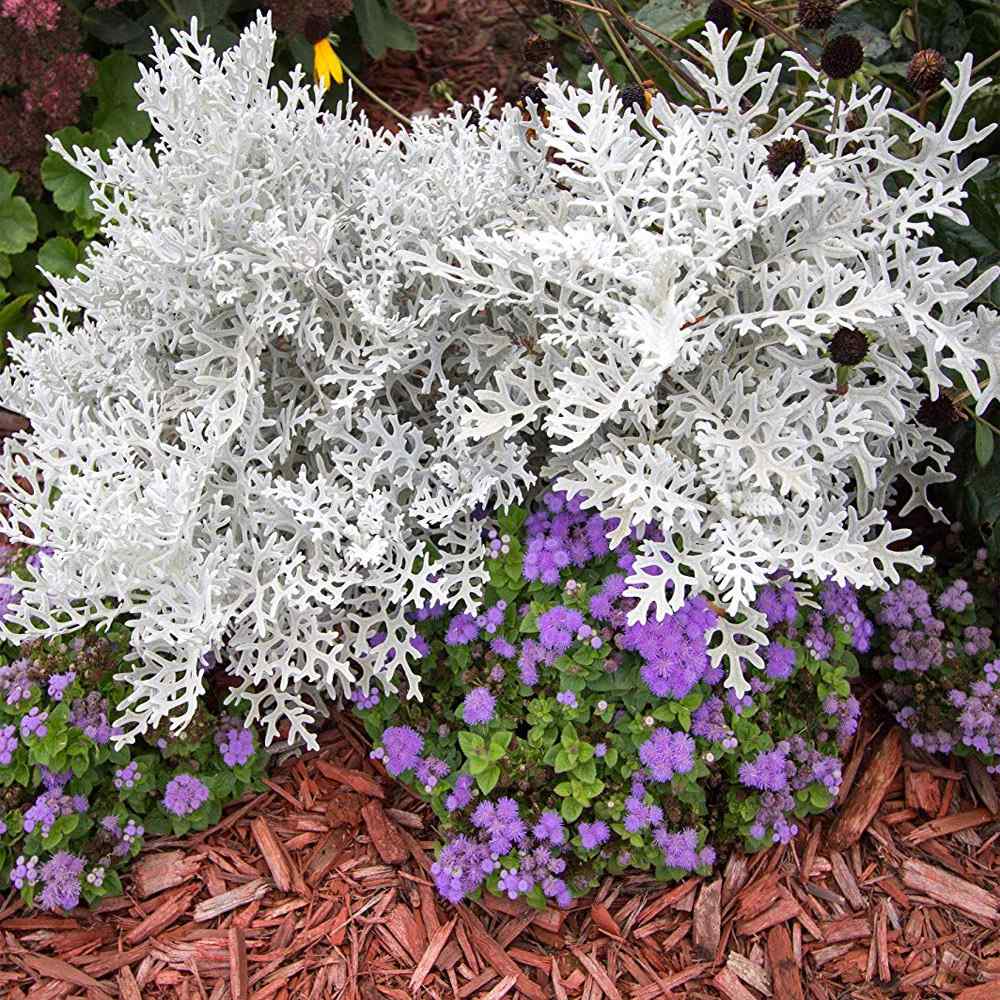
JB236 Dusty Miller ( Cineraria Maritima Silverdust )
This is known for its attractive silvery-gray foliage and mounding form and makes a lovely accent plant in the border or in containers. Dusty Miller Silverdust has lacy, lobed and deeply cut, silvery gray leaves and grows to 8 - 12 inches tall and wide. Dusty Miller plants can winter over and act like a perennial in warmer areas, and mulching helps it survive the winter. Another common name for Cineraria Maritima is Silver Ragwort. The botanical name may also be Senecio cineraria.
Dusty Miller produces flowers that are golden yellow in color. The silvery colored foliage makes a wonderful back-drop for brightly colored bedding plants. The contrasts can be very striking. Grows 8 to 12 inches tall. Good for pots and baskets.
Dusty Miller produces flowers that are golden yellow in color. The silvery colored foliage makes a wonderful back-drop for brightly colored bedding plants. The contrasts can be very striking. Grows 8 to 12 inches tall. Good for pots and baskets.
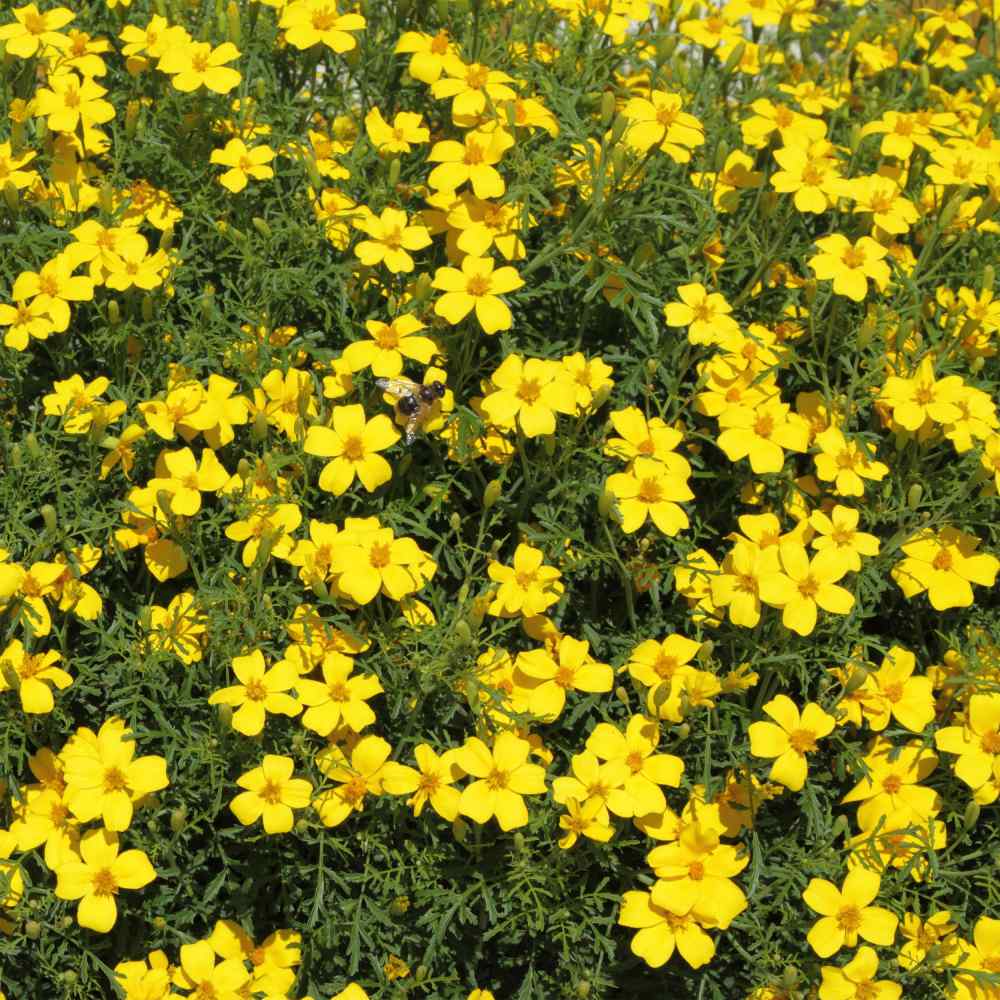
JB254 Hannay's Lemon Drop ( Bidens humilis )
Also known as Bur Marigold. Bidens Aurea seeds grow quickly and easily into a sweet annual that makes a nice addition to the garden. This tall, long-stemmed plant shimmers from mid-summer until fall, producing beautiful golden yellow flowers. Each simple, five-petaled daisy is two-toned, with paler, white-tipped petals set round a darker middle. The ferny foliage of the plant truly makes this a unique flower grown from flower seeds.
Not too many gardeners know about Bidens Aurea. This hidden secret is making its way to popularity as people are appreciating its unique attributes. Bur Marigold will grow in clay and heavier soil as well as lighter soils, but it's more likely to run on lighter ground. In can self-sow with the seeds popping up some distance away, weaving itself among other plants. It does not smother or crowd other plants. Grow the flower seed in baskets, containers, or directly in the flower garden.
An annual growing about 18 inches tall.
Not too many gardeners know about Bidens Aurea. This hidden secret is making its way to popularity as people are appreciating its unique attributes. Bur Marigold will grow in clay and heavier soil as well as lighter soils, but it's more likely to run on lighter ground. In can self-sow with the seeds popping up some distance away, weaving itself among other plants. It does not smother or crowd other plants. Grow the flower seed in baskets, containers, or directly in the flower garden.
An annual growing about 18 inches tall.
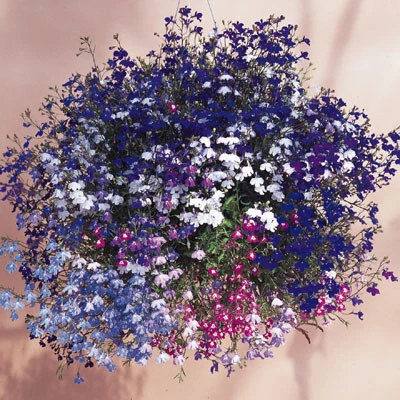
D9903 Regatta Mix Lobelia
The Regatta lobelia series is a superior, quick blooming trailing variety that continues to look good and flower heavily all summer. Regatta lobelias are superb performers in hanging baskets or borders.
Flowers up to 4 weeks earlier than other trailing varieties. Vigorous plants flower profusely, cascading over the edge of hanging baskets, larger containers and colour bowls. Grows about 6 inches tall. Annual.
Flowers up to 4 weeks earlier than other trailing varieties. Vigorous plants flower profusely, cascading over the edge of hanging baskets, larger containers and colour bowls. Grows about 6 inches tall. Annual.
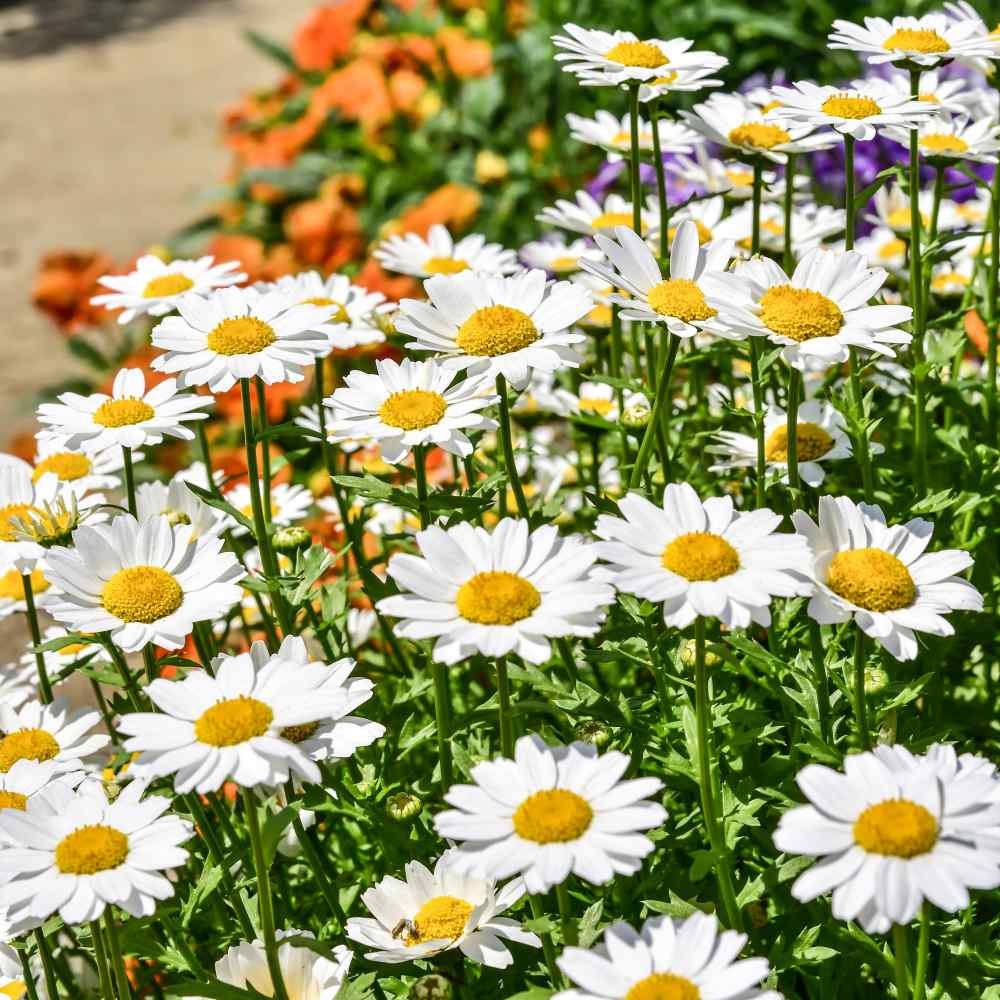
JB169 Creeping Daisy ( Chrysanthemum Paludosum )
Easy to grow from flower seeds and quick to flower with a spreading habit, these little Creeping Daisies are a great filler for garden beds, rock gardens, containers, and window boxes. Chrysanthemum Paludosum seeds produce a compact, low growing flowering plant that has 1 1/2 inch flowers. Deadheading and pinching help maintain the compact growth. Creeping Daisy plants typically only grow about 6 - 12 inches tall, but they will spread to 15 inches in no time. Chrysanthemum Paludosum does not waste anytime. After being sown from flower seeds, it blooms in about 12 weeks! Creeping Daisy ground cover is perfect for sunny sites and it's usually resistant to deer.
Butterflies love to visit these sweet little flowers! Chrysanthemums can be liberal self-sowers, and Creeping Daisy will drop its own flower seeds giving you brand new Creeping Daisy plants the following year. Creeping Daisy is technically a perennial, but only in frost free zones 9 and 10.
Creeping Daisy seeds can be sown directly outside in the spring after frost season is over. In a prepared seedbed that is weed free, so the flower seeds about 12 inches apart and press the Chrysanthemum seeds into the soil. Keep the seeds moist until germination occurs. Creeping Daisy care includes an application of all purpose fertilizer each month throughout the growing season and pinching back spent flowers to encourage continued blooming.
Butterflies love to visit these sweet little flowers! Chrysanthemums can be liberal self-sowers, and Creeping Daisy will drop its own flower seeds giving you brand new Creeping Daisy plants the following year. Creeping Daisy is technically a perennial, but only in frost free zones 9 and 10.
Creeping Daisy seeds can be sown directly outside in the spring after frost season is over. In a prepared seedbed that is weed free, so the flower seeds about 12 inches apart and press the Chrysanthemum seeds into the soil. Keep the seeds moist until germination occurs. Creeping Daisy care includes an application of all purpose fertilizer each month throughout the growing season and pinching back spent flowers to encourage continued blooming.
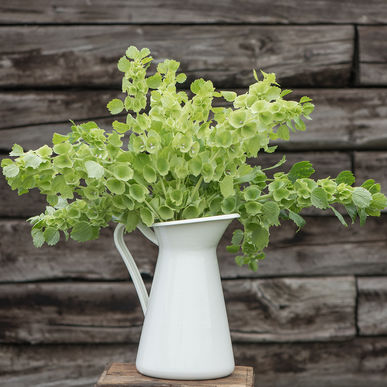
SF348 Bells of Ireland ( Molucella laevis )
Bells of Ireland is a lightly scented plant that grows 24 to 36 inches tall. The 1- to 2-inch, white-veined green bells that cling closely to stems are not really flowers but enlarged calyxes--the outer leaves that appear at the base of most flowers. The true flowers, tiny, fragrant and white, are deep within the bells. The popular names alluding to Ireland have been applied to this plant only because of the green color of the bells, not because the plant comes from Ireland; it is native to the eastern Mediterranean region, primarily Syria.
Bells-of-Ireland makes interesting and long-lasting cut flowers, and have additional value as dried flowers for winter arrangements. Dry them in a cool, dark, airy location and pick the sparse prickly-textured leaves off the stems so that the bells become more conspicuous. Whether you plan to use them in fresh or dried arrangements, the best time to cut is when the flowers are well-formed. Annual.
Bells-of-Ireland makes interesting and long-lasting cut flowers, and have additional value as dried flowers for winter arrangements. Dry them in a cool, dark, airy location and pick the sparse prickly-textured leaves off the stems so that the bells become more conspicuous. Whether you plan to use them in fresh or dried arrangements, the best time to cut is when the flowers are well-formed. Annual.
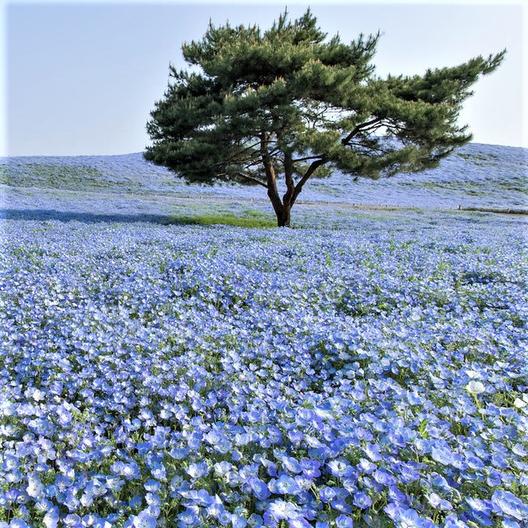
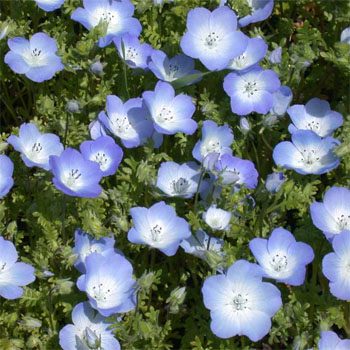
1A402 Baby Blue Eyes ( Nemophila insignis )
A hardy annual native to California, but is easily grown throughout the United States. The delicate, sky blue, cup shaped flowers continue to bloom throughout spring. Requires a light, sandy soil with moderate amounts of water.
Prefers partial shade, but in cooler climates can tolerate full sun. A charmer in wooden barrels and hanging baskets, wonderful flowerbed plant.
Also excellent for borders, rock gardens, hanging baskets. An enjoyable and easily grown variety from seed.
This low growing plant requires little maintenance. Does not transplant well.
Prefers partial shade, but in cooler climates can tolerate full sun. A charmer in wooden barrels and hanging baskets, wonderful flowerbed plant.
Also excellent for borders, rock gardens, hanging baskets. An enjoyable and easily grown variety from seed.
This low growing plant requires little maintenance. Does not transplant well.
Seedman Basic Info:
Grows 6-12 inches tall, will germinate in about 7-30 days depending on soil and weather conditions, does not germinate well in hot weather, germinates best if soil temperature is in the 55°F to 65°F range.
Cover seeds about 1/8" deep, blooms from March to May.
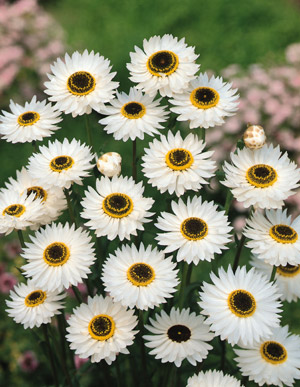
FB171 Pierrot Paper Daisy ( Helipterum roseum )
Beautiful growing in the summer flower border, this annual is a heavy bloomer and is easily grown form Helipterum seed. The common name of Paper Daisy describes the texture of the white flower petals. Another common name, Everlasting Daisy, is given because Helipterum flowers dry and preserve exceptionally well, keeping their color indefinitely. To dry Paper Daisy flowers, cut when the foliage is dry and the flowers are well open, tie the stems in small bunches and hang in a dry, well-ventilated room until dry. To keep the Helipterum plant blooming all summer and into the fall, keep the spent flowers deadheaded.
Fleuroselect, exciting color combo of snow white petals with yellow bordered black center, gray green leaf, for garden or cut, grows 22" tall, ready in 9 weeks from seed. Annual.
Fleuroselect, exciting color combo of snow white petals with yellow bordered black center, gray green leaf, for garden or cut, grows 22" tall, ready in 9 weeks from seed. Annual.
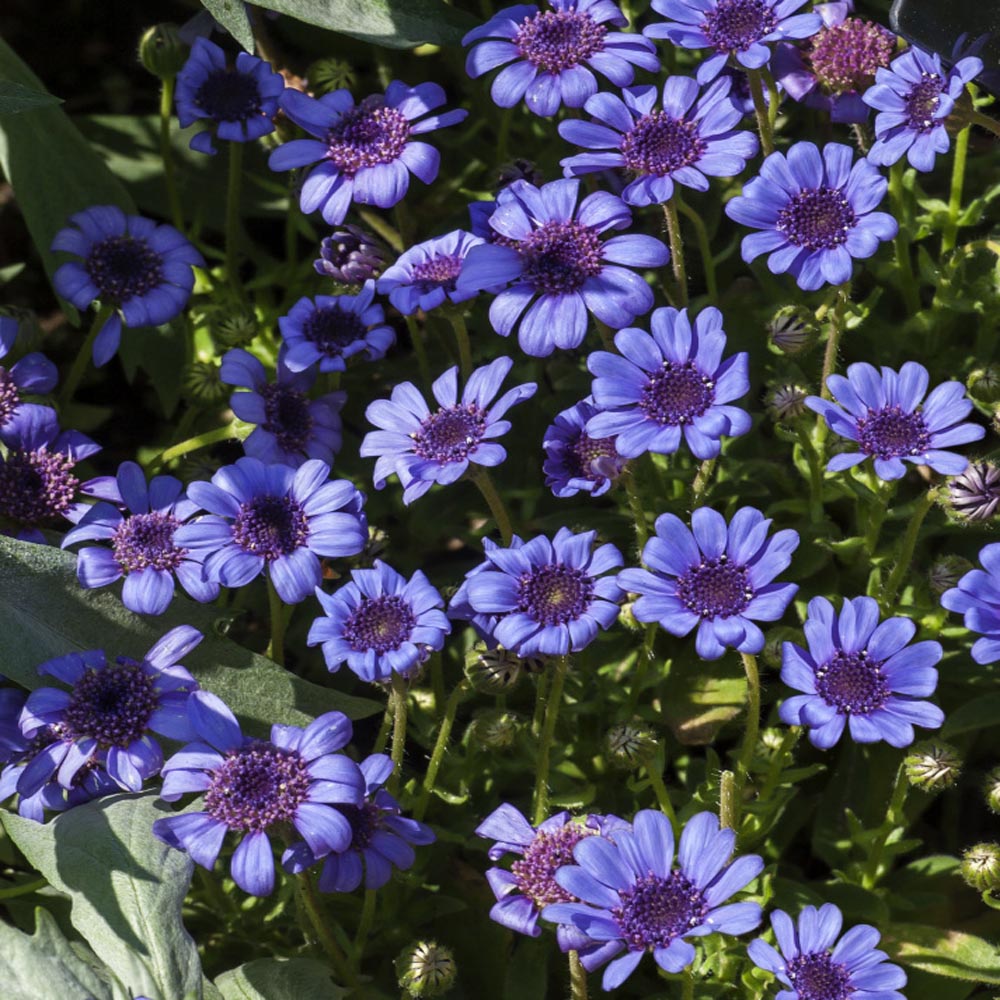
JB234 The Blues Blue Daisy ( Felicia Heterophylla Blue )
If blue is one of your favorite colors, you will need to start some of this Blue Daisy seed! The Blues Blue Daisy has a profusion of gorgeous sky-blue flowers that rise above tidy, compact foliage.Also called Blue Kingfisher Daisy, this daisy does well in rocky or sandy soil and makes a beautiful cut flower, often grown in cutting gardens. Grows about 10 inches tall. Annual.
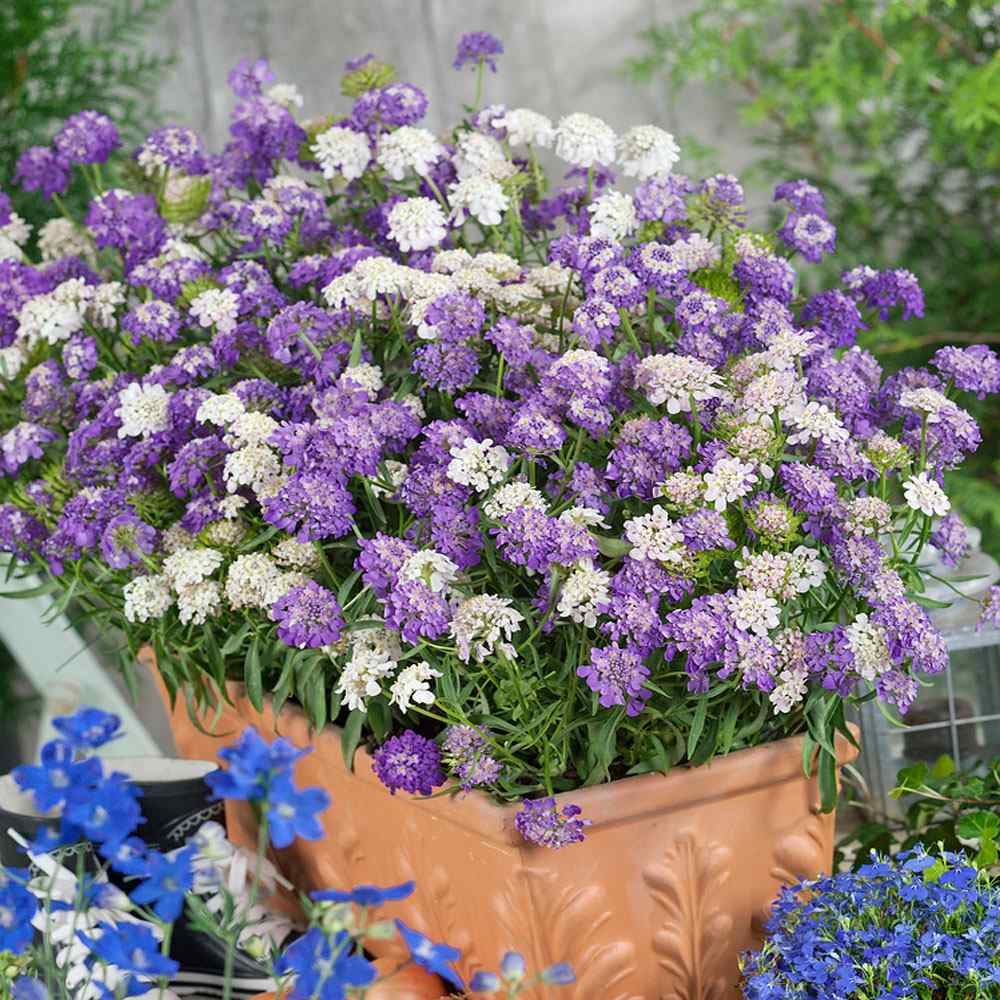
TPF028 Candytuft ( Iberis umbellata )
This wild flower is so easy to grow from Candytuft seeds! Annual Candytuft is a wild flower that is just about as wonderful as its cousin which is perennial Candytuft. When planted from wildflower seed, it begins flowering within just a few short months with colors ranging from white to pink to purple. It is taller and less compact than perennial Candytuft, but as you can see, the colors are striking and it makes a wonderful addition to the wild flower seed garden or to use as a taller ground cover plant.
Annual Iberis is often sold and planted by itself, or it can commonly be found in wild flower seed mixes due to its easy seeding and growth habits. If you want to start a wildflower garden but really don't have a clue how and what to do, Iberis Umbellata Candytuft is a good wild flower seed to start with. You can simply broadcast the Candytuft seeds, lightly rake it, keep it moist and before long you will have a brilliant display of flowers. People will think you are a wildflower expert! This is also a good ground cover plant for gardening with kids because it grows and flowers so fast from flower seed. If your winters are not harsh, wild Candytuft can survive the winters. It is best to snip the seed pods after flowering and give it a good bed of mulch in the fall to increase its survival rate.
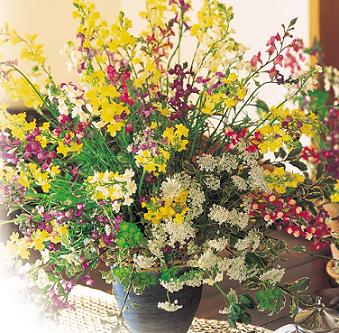
TPF079 Linaria Heavenly Mix ( Linaria maroccana
)
What a spectacular display of colors from Toadflax seeds. This wildflower seed is extremely tiny, but it is easy to grow and very rewarding. Native to Morocco, Linaria, also called Baby Snapdragon, is an upright, branching annual that typically grows to 9 - 18 inches tall. It features long-spurred, two-lipped, miniature snapdragon-like flowers and small lance-shaped fleshy blue green leaves. The flowers bloom spring to fall in cool summer climates, but usually stop blooming in the heat of summer in hot climates. In the wild, the Baby Snapdragon Toadflax bloom color is usually purple-violet with a yellow blotch on the palate. Cultivars extend the color range to include shades of lavender, yellow, orange, pink, red and white, usually with contrasting color blotches on the palates. Very lovely and perfect for the front of the flower border. Hummingbirds and butterflies will visit Toadflax wildflowers often!
How To Grow Toadflax: Sow Toadflax seeds outdoors as soon as the ground can be worked. Prepare the seedbed by weeding and loosening the soil. Press the Baby Snapdragon wildflower seeds into the soil but do not cover it. Keep it moist until germination. Grown as annual.
How To Grow Toadflax: Sow Toadflax seeds outdoors as soon as the ground can be worked. Prepare the seedbed by weeding and loosening the soil. Press the Baby Snapdragon wildflower seeds into the soil but do not cover it. Keep it moist until germination. Grown as annual.
Perennial Plants
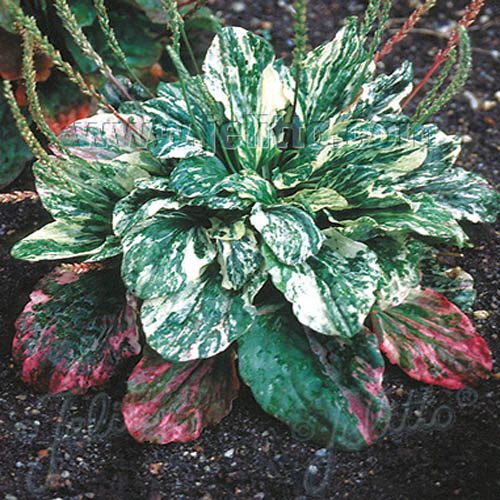
SF326 Variegated Plantain (Plantago Major Variegata)
The cream and green marbled leaves form a basal rosette of oval leaves. Small green flowers on narrow spike in June to July. Self-seeds easily, remove flowers in self-seeding is not desired. This mound of variegated plantain leaves is great just to marvel at; however, variegated plantain leaves also work well for bee-stings! Plant this interesting novelty for a walkway or pathway planting in sun to open part shade.
For millennia, poultices of plantain leaves have been applied to wounds, sores, and stings to promote healing.
A hardy perennial for zones 3-9. Grows about 10 inches tall.
Basic Seedsowing Info:
Sow inside at 68 degrees, if no germination in 3 to 4 weeks, move to 24-39 degrees ( fridge ) for 2-4 weeks. Average Germ Time: 21-28 days. Light required to germinate. Cover 1/16 inch. Keep seeds moist until germination.
For millennia, poultices of plantain leaves have been applied to wounds, sores, and stings to promote healing.
A hardy perennial for zones 3-9. Grows about 10 inches tall.
Basic Seedsowing Info:
Sow inside at 68 degrees, if no germination in 3 to 4 weeks, move to 24-39 degrees ( fridge ) for 2-4 weeks. Average Germ Time: 21-28 days. Light required to germinate. Cover 1/16 inch. Keep seeds moist until germination.
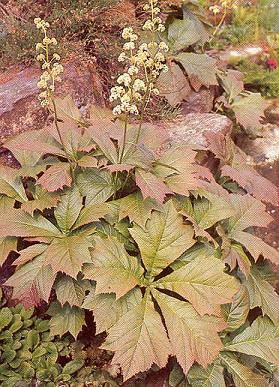
TWT138 Rodger's Flower ( Rodgersia Henrici Hybrids
)
Rodgersias have bold textured leaves that take on beautiful red and bronze tones in the fall. The flowers are a fluffy rose pink that are held high above the foliage and then followed by interesting seed heads. The course foliage makes it excellent as a specimen plant. Give them planty of room as they will become massive in size once established.
With its bold, divided leaves this forms an exotic-looking clump that adds a unique foliage accent to any moist border. Large airy plumes of soft-pink to rose-purple flowers appear in early to mid-summer, and these are useful for cutting or even drying.
Slowly gaining popularity as a unique plant in the shade garden, used primarily as a specimen, foliage has a coarse texture unlike many other shady perennials, does not like heavy clay soil. Bold, hardy, large fingered leaf with puffy bright pink blooms for moist areas as well. Grows 30 inches tall, hardy for zone 3 and higher.
With its bold, divided leaves this forms an exotic-looking clump that adds a unique foliage accent to any moist border. Large airy plumes of soft-pink to rose-purple flowers appear in early to mid-summer, and these are useful for cutting or even drying.
Slowly gaining popularity as a unique plant in the shade garden, used primarily as a specimen, foliage has a coarse texture unlike many other shady perennials, does not like heavy clay soil. Bold, hardy, large fingered leaf with puffy bright pink blooms for moist areas as well. Grows 30 inches tall, hardy for zone 3 and higher.
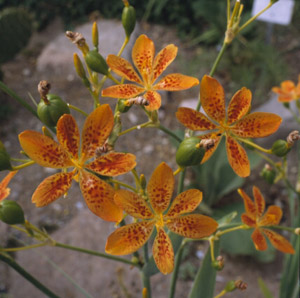
IP072 Blackberry Lily ( Belamcanda chinensis )
A wonderful perennial plant for zones 4-10 for cutting gardens, flower beds and mass plantings. Grows 24-36 inches tall and blooms all summer through fall.
Native to China and Japan. Also called Leopard Lily the plant has iris-like medium-green foliage with tall upright lives. This lily is long blooming and blooms with very showy deep-orange flowers 2 inches in diameter. The 6 petal flowers are spotted profoundly with red dots. Blackberry Lily features distinctive seed pods that look like blackberry seed clusters.
Normally planted in cutting gardens and shrub borders. When mass planted, Blackberry Lilies makes a remarkable display in any landscape. Leopard Lily is drought tolerant and likes to grow in full sun or light shade. The well-drained soil is preferable for the best performance. This variety of Blackberry Lily calls Freckle Face, and it is pest and disease resistant. The plant is an exceptional cut flower and can be dried too.
Native to China and Japan. Also called Leopard Lily the plant has iris-like medium-green foliage with tall upright lives. This lily is long blooming and blooms with very showy deep-orange flowers 2 inches in diameter. The 6 petal flowers are spotted profoundly with red dots. Blackberry Lily features distinctive seed pods that look like blackberry seed clusters.
Normally planted in cutting gardens and shrub borders. When mass planted, Blackberry Lilies makes a remarkable display in any landscape. Leopard Lily is drought tolerant and likes to grow in full sun or light shade. The well-drained soil is preferable for the best performance. This variety of Blackberry Lily calls Freckle Face, and it is pest and disease resistant. The plant is an exceptional cut flower and can be dried too.
D4535 Asparagus Fern ( Sprengeri )
The Asparagus Fern features trailing bright glossy foliage. When planted in containers, the unique feathery foliage makes a lovely complement to flowers. It makes an excellent house plant and works well in hanging baskets. Asparagus Fern is a slightly woody evergreen plant with upright or trailing branches. It is easily established from flower seed, and it is easy to grow and drought-tolerant. This fern-like perennial develops into a fast-growing, sprawling ground cover, or a nice-sized houseplant that requires minimal care.
Grows 24 inches in height and 24 - 36 inches wide in full to part sun. Grown in some shade, the foliage will maintain a deeper green color. It likes moist but well-drained soil.
Asparagus Fern produces a flower. The flowering time lasts for roughly two weeks during the summer. Bright red berries follow the inconspicuous, fragrant white or pale pink flowers. Birds are highly attracted to the fruit and aid in the dispersal of the flower seed. Sow Asparagus Fern seeds in potting mix indoors. Transplant outdoors after danger of frost.
Grows 24 inches in height and 24 - 36 inches wide in full to part sun. Grown in some shade, the foliage will maintain a deeper green color. It likes moist but well-drained soil.
Asparagus Fern produces a flower. The flowering time lasts for roughly two weeks during the summer. Bright red berries follow the inconspicuous, fragrant white or pale pink flowers. Birds are highly attracted to the fruit and aid in the dispersal of the flower seed. Sow Asparagus Fern seeds in potting mix indoors. Transplant outdoors after danger of frost.
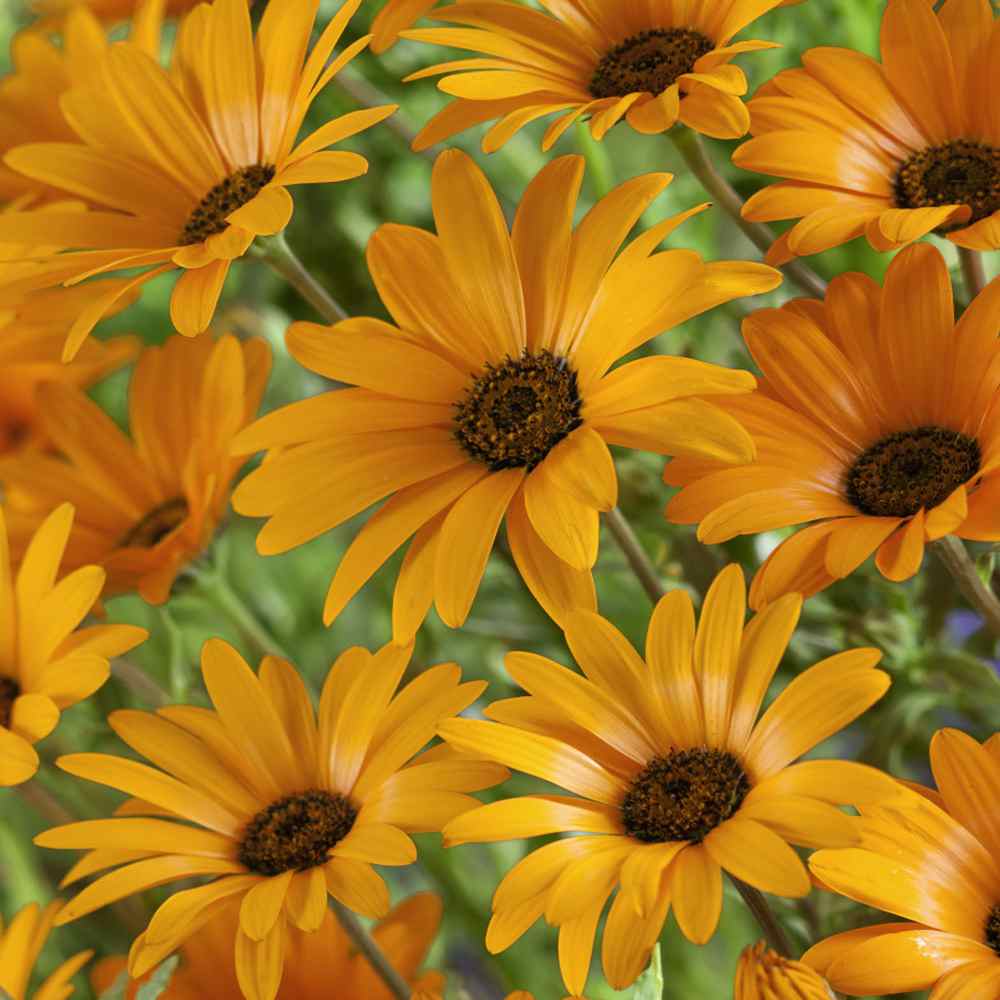
JB192 Sinuata Orange ( Dimorphotheca aurantiaca )
The striking daisy-shaped flowers attract butterflies into the garden. Bees also love this flowering plant as they collect the nectar from the flowers. The plants are easily grown from flower seeds, and it is an annual that grows up to 12 inches tall.
They leaves are slender, spoon-shaped, reaching up to 3 inches long. The stems are reddish in color and are often covered by the masses of leaves around them. Features remarkably big orange flowers that have orange centers. They need full sun to open and they always face the sun.
Grows about 12 inches tall, a perennial for zones 3-10.
They leaves are slender, spoon-shaped, reaching up to 3 inches long. The stems are reddish in color and are often covered by the masses of leaves around them. Features remarkably big orange flowers that have orange centers. They need full sun to open and they always face the sun.
Grows about 12 inches tall, a perennial for zones 3-10.
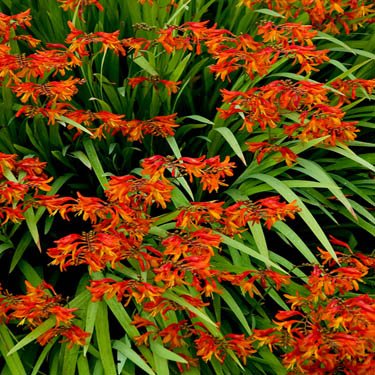
SF335 Crocosmia ( Crocosmia Paniculata Hybrida )
Crocosmia are a popular and attractive flowering plant. Native to South Africa, Crocosmia are members of the Iris family and are easy to grow from flower seeds. Crocosmia plants grow two feet tall in a season. Tube shaped flower colors include red, yellow, orange-yellow, and orange with splotches. Crocosmia flowers bloom from July through October.
Crocosmia grow well in the flower garden and in containers on patios or decks. You should experience few problems with your Crocosmia. Use insecticide or fungicide, only if a problem occurs. Crocosmia are tough when it come to winter temperatures tolerating temperatures down to USDA Zone 5. A perennial for zones 5-9.
Crocosmia grow well in the flower garden and in containers on patios or decks. You should experience few problems with your Crocosmia. Use insecticide or fungicide, only if a problem occurs. Crocosmia are tough when it come to winter temperatures tolerating temperatures down to USDA Zone 5. A perennial for zones 5-9.
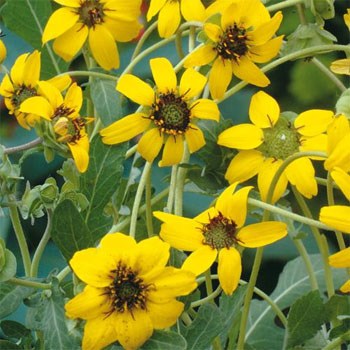
JB279 Chocolate Scented Daisy ( Berlandiera Lyrata )
A wonderful perennial plant with a sweet chocolate fragrance. Also known as Chocolate flower, this is a night bloomer, the flowers offer up their rich cocoa scent in the morning. As the temperature rises the petals close or drop and the fragrance recedes.
The Chocolate Flower plant starts out small, but each spring the crown grows larger and the plant can eventually spread to about 24 inches across. Chocolate Daisies have a rather airy growth, and they make a nice informal edging plant. Berlandiera is most impressive and most fragrant when planted in groups. Chocolate Flowers are night time bloomers, and their cocoa scent is strongest in the morning hours.
For zones 4-10, grows about 12-18" tall.
The Chocolate Flower plant starts out small, but each spring the crown grows larger and the plant can eventually spread to about 24 inches across. Chocolate Daisies have a rather airy growth, and they make a nice informal edging plant. Berlandiera is most impressive and most fragrant when planted in groups. Chocolate Flowers are night time bloomers, and their cocoa scent is strongest in the morning hours.
For zones 4-10, grows about 12-18" tall.
Start seeds directly outdoors once frost danger has passed. Prepare a seedbed by loosening the soil to a depth of about 8 inches and removing all weeds. Lightly cover the seeds with soil and keep the flower seeds moist until germination occurs. Thin the seedlings to about 18 inches apart when they are several inches in height. Care of the plant includes removing spent flowers to encourage continued blooming, and cutting the entire plant back in the fall after blooming is finished.
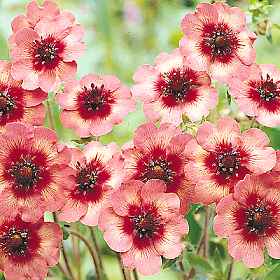
JB076 Melton Fire ( Potentilla nepalensis )
Tricolor flowers of deep red, soft crimson, and vanilla on spreading plants, excellent container plant, grows about 16" tall. Drought tolerant. Deer resistant. Evergreen ground cover and border plant. Excellent cut flower. An almost perpetual flowering hybrid, this mounder produces its large bicolored strawberry-red ; lemon-yellow flowers all summer. Perennial, Zones 4-9.
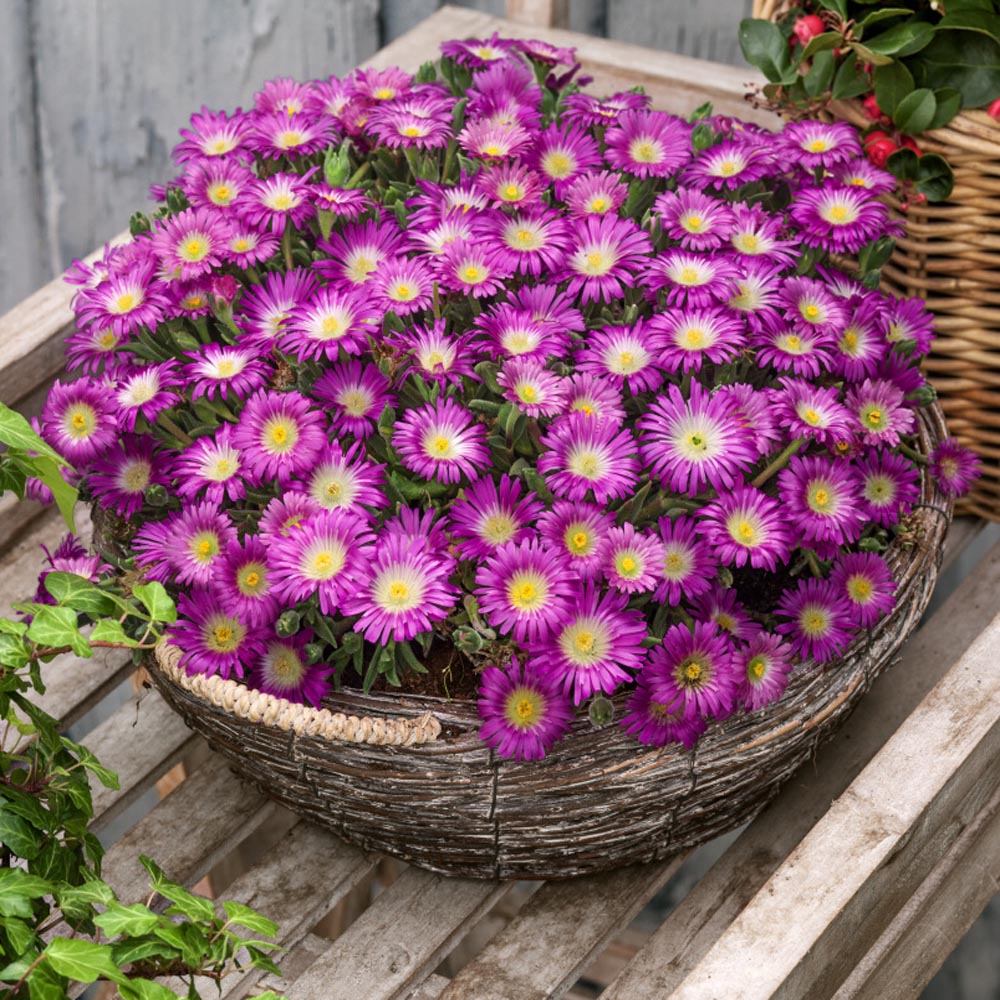
TCB106 Table Mountain Pelleted ( Delosperma cooperi )
It only takes 4 months from seeds to enjoy this ground cover plant and the brilliant fuchsia blooms they provide. This hardy, drought-tolerant ground cover plant forms a ground-hugging carpet that faithfully blooms season after season. A mainstay of the water-saving or dry-climate garden, this hardy Ice Plant is a colorful ground cover that blooms with little to no care!
Table Mountain has foliage that is deep green, almost succulent looking and extremely shiny. The blooms are 1 - 2 inches across and cover the foliage, opening in the morning and closing in the evening. Ice Plants make a great under planting for roses and taller shrubs. They also work well in a container as long as their situation is sunny and well-draining.
Pelleted seeds for easy sowing. A perennial growing 2 to 3 inches tall, for zones 4-9.
Table Mountain has foliage that is deep green, almost succulent looking and extremely shiny. The blooms are 1 - 2 inches across and cover the foliage, opening in the morning and closing in the evening. Ice Plants make a great under planting for roses and taller shrubs. They also work well in a container as long as their situation is sunny and well-draining.
Pelleted seeds for easy sowing. A perennial growing 2 to 3 inches tall, for zones 4-9.

SF293 Cherry Brandy ( Rudbeckia hirta )
A stunning introduction in shades of luscious cherry-red, ranging from bright solids to subtle bicolors with deep red centers.
Creates plenty of drama without overpowering companion plantings and cut flower arrangements. Plants are heat tolerant and prolific, producing masses of color from late June until early frost.
Will flower at 12" when grown in pots, but becomes truly statuesque in the garden.
First red wine-colored Rudbeckia from seed. Compact plants are outstanding in the garden or in large containers. Combine Cherry Brandy's 3–4" flowers with rudbeckia of other colors, or do a dramatic mass planting for red blooms all summer. Also known as blackeyed Susan and gloriosa daisy. Tender perennial in Zones 9–10. Ht. 20–24".
Creates plenty of drama without overpowering companion plantings and cut flower arrangements. Plants are heat tolerant and prolific, producing masses of color from late June until early frost.
Will flower at 12" when grown in pots, but becomes truly statuesque in the garden.
First red wine-colored Rudbeckia from seed. Compact plants are outstanding in the garden or in large containers. Combine Cherry Brandy's 3–4" flowers with rudbeckia of other colors, or do a dramatic mass planting for red blooms all summer. Also known as blackeyed Susan and gloriosa daisy. Tender perennial in Zones 9–10. Ht. 20–24".
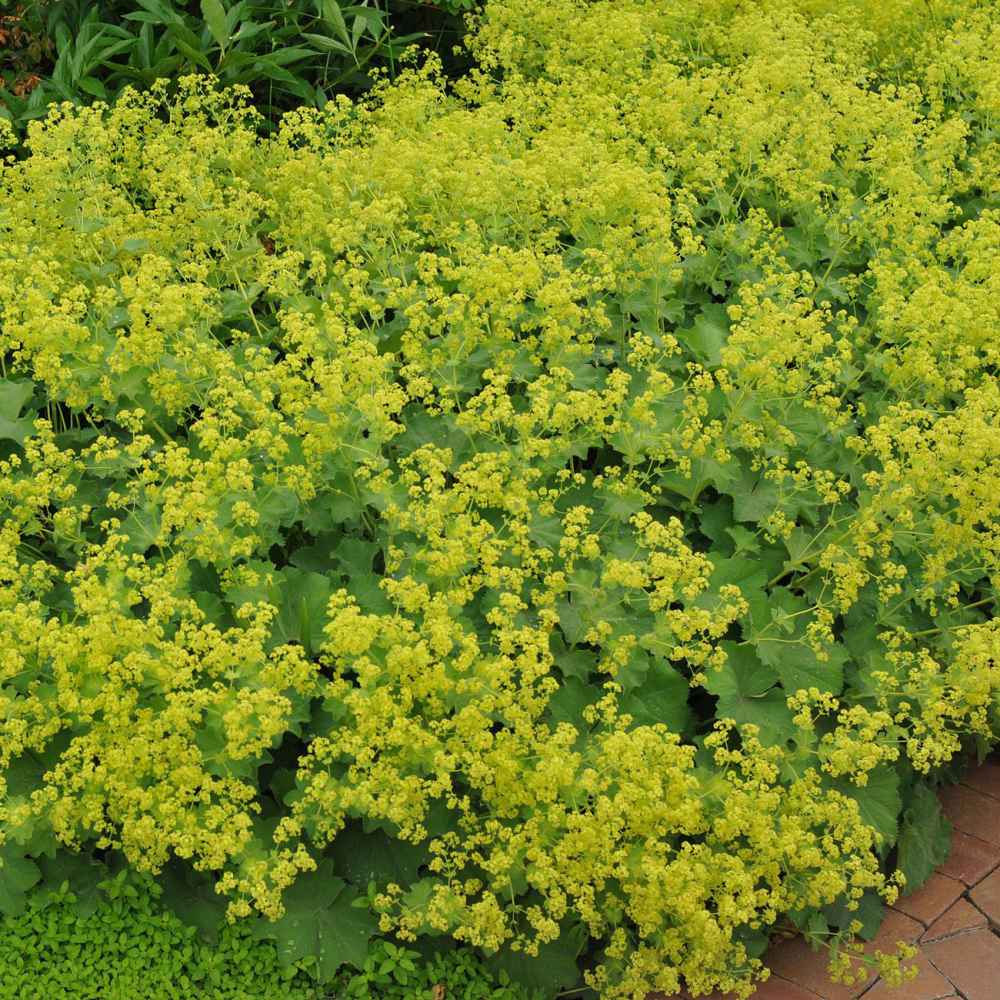
JB116 Lady's Mantle ( Alchemilla mollis )
This popular flower is perfect for the garden. With its olive colored, crimped velvety leaves which cup to capture the dew and rain and its frothy sprays of yellow clusters, it is certainly appealing to the eye. The Achemilla Mollis plant is bushy and makes an excellent border or edging plant. The Lady's Mantle flowers are excellent for cutting, and the yellow blooms work in nicely in flower arrangements
Lady’s mantle is an interesting plant to add to the garden, especially in shady borders. It is also commonly used as a ground cover and makes a nice edging when kept in bounds. You may find lady’s mantle in wreaths and bouquets as well, either freshly cut or dried.
The name alludes to the fanlike shape of this plant's light green foliage. A cottage garden classic, it produces masses of tiny, greenish-yellow blooms that erupt from fan-shaped foliage. Extremely drought tolerant and an excellent cover plant, it will thrive in sun or shade; a wonderful companion for roses. Long lasting as cut flowers. A perennial for zones 3-8, growing in clumps about 20 inches tall.
Lady’s mantle is an interesting plant to add to the garden, especially in shady borders. It is also commonly used as a ground cover and makes a nice edging when kept in bounds. You may find lady’s mantle in wreaths and bouquets as well, either freshly cut or dried.
The name alludes to the fanlike shape of this plant's light green foliage. A cottage garden classic, it produces masses of tiny, greenish-yellow blooms that erupt from fan-shaped foliage. Extremely drought tolerant and an excellent cover plant, it will thrive in sun or shade; a wonderful companion for roses. Long lasting as cut flowers. A perennial for zones 3-8, growing in clumps about 20 inches tall.
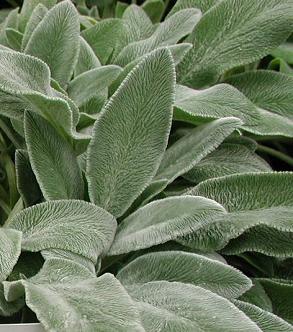
IP186 Fuzzy Wuzzy Lambs Ear ( Stachys byzantina )
Velvety soft,silver-gray leaves are shaped and feel like a lamb's ear. Lavender flower on short spikes in July. Tolerates drought, heat and humidity.
Lamb's-ears are one of the most popular foliage perennials, used widely for edging along pathways and borders, but it also makes a nice inside plant as it tolerates the dry air and lower light levels inside very well.
This strain forms a dense carpet of soft and fuzzy silver leaves, bearing upright spikes of magenta-lavender flowers in early summer. Clip spent bloom stems off to tidy up the clumps for the rest of the season. If you tire of it inside, simply plant it outside in the flower garden.
Clumps are easily divided in spring or early fall. Evergreen in mild winter regions.
Zones 3-9.
Lamb's-ears are one of the most popular foliage perennials, used widely for edging along pathways and borders, but it also makes a nice inside plant as it tolerates the dry air and lower light levels inside very well.
This strain forms a dense carpet of soft and fuzzy silver leaves, bearing upright spikes of magenta-lavender flowers in early summer. Clip spent bloom stems off to tidy up the clumps for the rest of the season. If you tire of it inside, simply plant it outside in the flower garden.
Clumps are easily divided in spring or early fall. Evergreen in mild winter regions.
Zones 3-9.
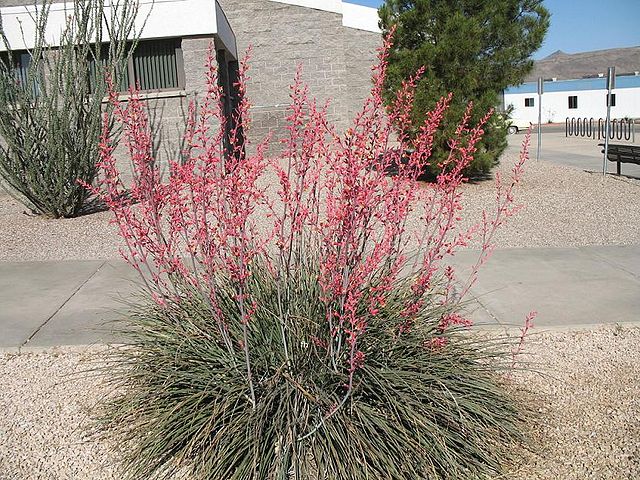
Image: Fritz Hochstätter, CC BY-SA 3.0 DE, via Wikimedia Commons
JB163 Red Yucca ( Hesperaloe parviflora )
Also known as red yucca, hummingbird yucca, redflower false yucca and samandoque, is a plant that is native to Chihuahuan desert of west Texas east and south into central and south Texas and northeastern Mexico around Coahuila.
Hesperaloe parviflora has narrow evergreen leaves with a fringe of white threadlike hairs along their edges and grows in clumps 3–6 feet high and wide. Red or yellow tubular flowers are borne on branching flower stalks (inflorescences) up to 5 feet tall from late spring to mid-summer.
This species has become popular in xeriscape landscape design for public and private gardens in California and the Southwestern United States. The plant's qualities include drought tolerance, heat resistance, low maintenance needs, hummingbird attracting flowers, and an architectural form. It also is a spineless alternative to Agave and Yucca horticultural species.
Hardy to well below 0°F some say as low as -20°F (USDA zone 5). It is a good clean plant for desert and succulent gardens, planted in masses or used in pots.
Hesperaloe parviflora has narrow evergreen leaves with a fringe of white threadlike hairs along their edges and grows in clumps 3–6 feet high and wide. Red or yellow tubular flowers are borne on branching flower stalks (inflorescences) up to 5 feet tall from late spring to mid-summer.
This species has become popular in xeriscape landscape design for public and private gardens in California and the Southwestern United States. The plant's qualities include drought tolerance, heat resistance, low maintenance needs, hummingbird attracting flowers, and an architectural form. It also is a spineless alternative to Agave and Yucca horticultural species.
Hardy to well below 0°F some say as low as -20°F (USDA zone 5). It is a good clean plant for desert and succulent gardens, planted in masses or used in pots.
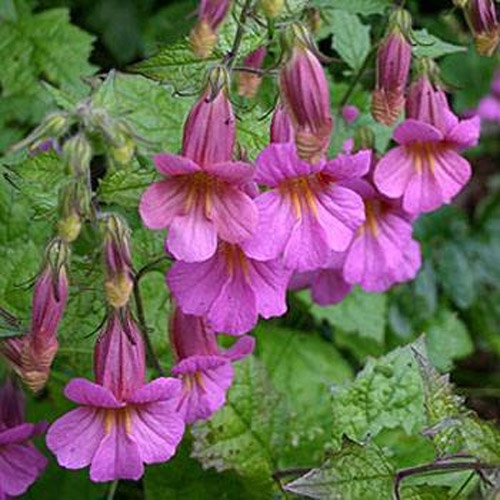
JB197 Chinese Foxglove ( Rehmannia elata )
Winner of the RHS Award of Garden Merit. Commonly called Chinese foxglove because the tubular flowers bear a resemblance to digitalis ( foxglove ). Pollinators love the trumpet-shaped flowers, which are a lovely shade of rose-pink with speckled yellow throats. The blooms dangle from slender stems that rise above a basal rosette of scalloped gray-green foliage. The airy and delicate blossoms of combine grace and color with a long season of bloom.
Easy to grow, it is a perennial but might not survive above zone 7 so grow it there as an annual. Blooms prolifically first year from seed if sown the previous fall. No garden should be without this lovely plant, it looks both dainty and really exotic.
Although Chinese foxglove is not as hardy as its lookalike, digitalis, it is more versatile, growing well in shade and is even fairly drought-tolerant. Mature Height: 24-36", Spacing: 12-18". Zones 7-10.
Easy to grow, it is a perennial but might not survive above zone 7 so grow it there as an annual. Blooms prolifically first year from seed if sown the previous fall. No garden should be without this lovely plant, it looks both dainty and really exotic.
Although Chinese foxglove is not as hardy as its lookalike, digitalis, it is more versatile, growing well in shade and is even fairly drought-tolerant. Mature Height: 24-36", Spacing: 12-18". Zones 7-10.

3335 Billy Buttons ( Craspedia Globosa )
For gardeners who are looking for rare and new flower varieties to add to their summer display, look no further than Billy Buttons, a very unique blooming plant that is a perennial wildflower native to New Zealand, Australia and Tasmania but is considered an annual here.
The brilliant yellow hue of these 1 inch globes make them a striking addition to the flower garden. Commonly known as Billy Button or Drumstick, Craspedia is considered a half-hardy annual here in the United States. It generally blooms all summer long, and is very popular for cutting and drying. The flower heads are tough and durable making an exceptional dried flower.
The brilliant yellow hue of these 1 inch globes make them a striking addition to the flower garden. Commonly known as Billy Button or Drumstick, Craspedia is considered a half-hardy annual here in the United States. It generally blooms all summer long, and is very popular for cutting and drying. The flower heads are tough and durable making an exceptional dried flower.
Sow seeds indoors 4-6 weeks before the last frost is expected. Sow the flower seeds on the surface and lightly cover with peat moss or sand. The flower seeds need light for germination. Transplant seedlings when there are at least 2 sets of true leaves. They prefer full sun and gritty, well-drained soil. Plants are tolerant of poor soil and drought.
Seed can also be sown directly outdoors after all danger of frost has passed. Prepare a seed bed with loosed soil and weed free, sow the seeds directly on the surface and lightly sprinkle peat moss or sand on top. Keep the flower seeds moist until germination. 24 inches tall. Annual.
Seed can also be sown directly outdoors after all danger of frost has passed. Prepare a seed bed with loosed soil and weed free, sow the seeds directly on the surface and lightly sprinkle peat moss or sand on top. Keep the flower seeds moist until germination. 24 inches tall. Annual.
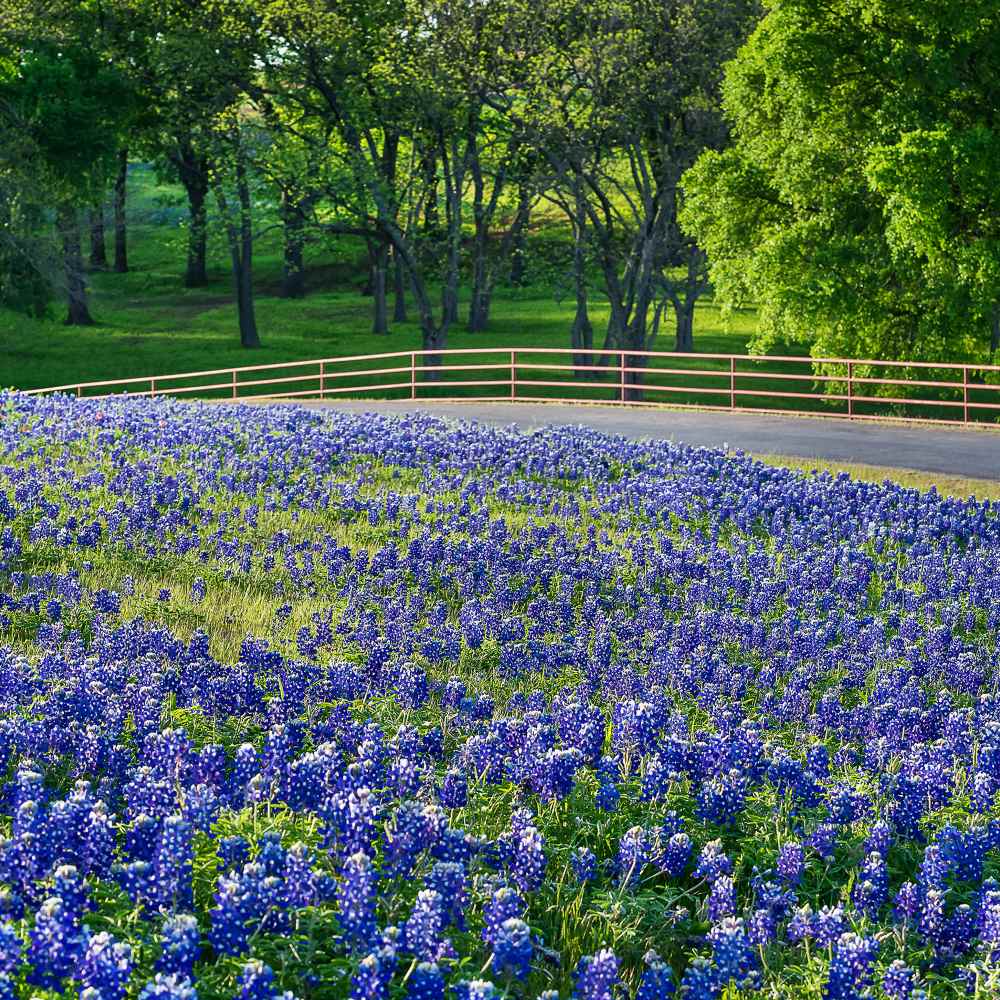
TPF275 Texas Bluebonnet ( Lupinus texensis )
No wildflower is so well known as Texas Bluebonnet. It's easily grown from seeds, and it can transform a field of little interest into a colorful display of lovely blue wild flowers! The Texas Bluebonnet wildflower was adopted as the State Flower of Texas in 1901 and is most often seen in beautiful floral displays along road sides, in woodlands, and in pastures all over the state. They begin to bloom in March and are usually in full bloom by April. Though native to Texas, these wild flowers will grow in other areas and when planted in mass, the visual effect is stunning. A sea of blue is created!
Low growing but prolific blooming, Texas Bluebonnet requires some patience, but little maintenance, once established. The same toughness and tenacity that makes this little Lupine the perfect representation of the Lone Star state also makes it slow to germinate and bloom--but once it does you will not be disappointed!
Bluebonnet flowers are prolific bloomers in early spring and are known for attracting butterflies and a variety of bees, including honeybees.
How To Grow Texas Bluebonnet From Seed: It is recommended to soak Texas Bluebonnet seeds in tepid water over night before sowing outdoors. After soaking, sow the Texas Bluebonnet wildflower seed directly into prepared soil that is loosened and weed free. A late fall sowing is recommended. To keep Texas Bluebonnet wildflowers year after year, allow the seed pods to form and drop their flower seeds. Texas Bluebonnet Lupine is moderately deer resistant and the flowers attract butterflies. An annual that will grow in zones 3-10.
Low growing but prolific blooming, Texas Bluebonnet requires some patience, but little maintenance, once established. The same toughness and tenacity that makes this little Lupine the perfect representation of the Lone Star state also makes it slow to germinate and bloom--but once it does you will not be disappointed!
Bluebonnet flowers are prolific bloomers in early spring and are known for attracting butterflies and a variety of bees, including honeybees.
How To Grow Texas Bluebonnet From Seed: It is recommended to soak Texas Bluebonnet seeds in tepid water over night before sowing outdoors. After soaking, sow the Texas Bluebonnet wildflower seed directly into prepared soil that is loosened and weed free. A late fall sowing is recommended. To keep Texas Bluebonnet wildflowers year after year, allow the seed pods to form and drop their flower seeds. Texas Bluebonnet Lupine is moderately deer resistant and the flowers attract butterflies. An annual that will grow in zones 3-10.
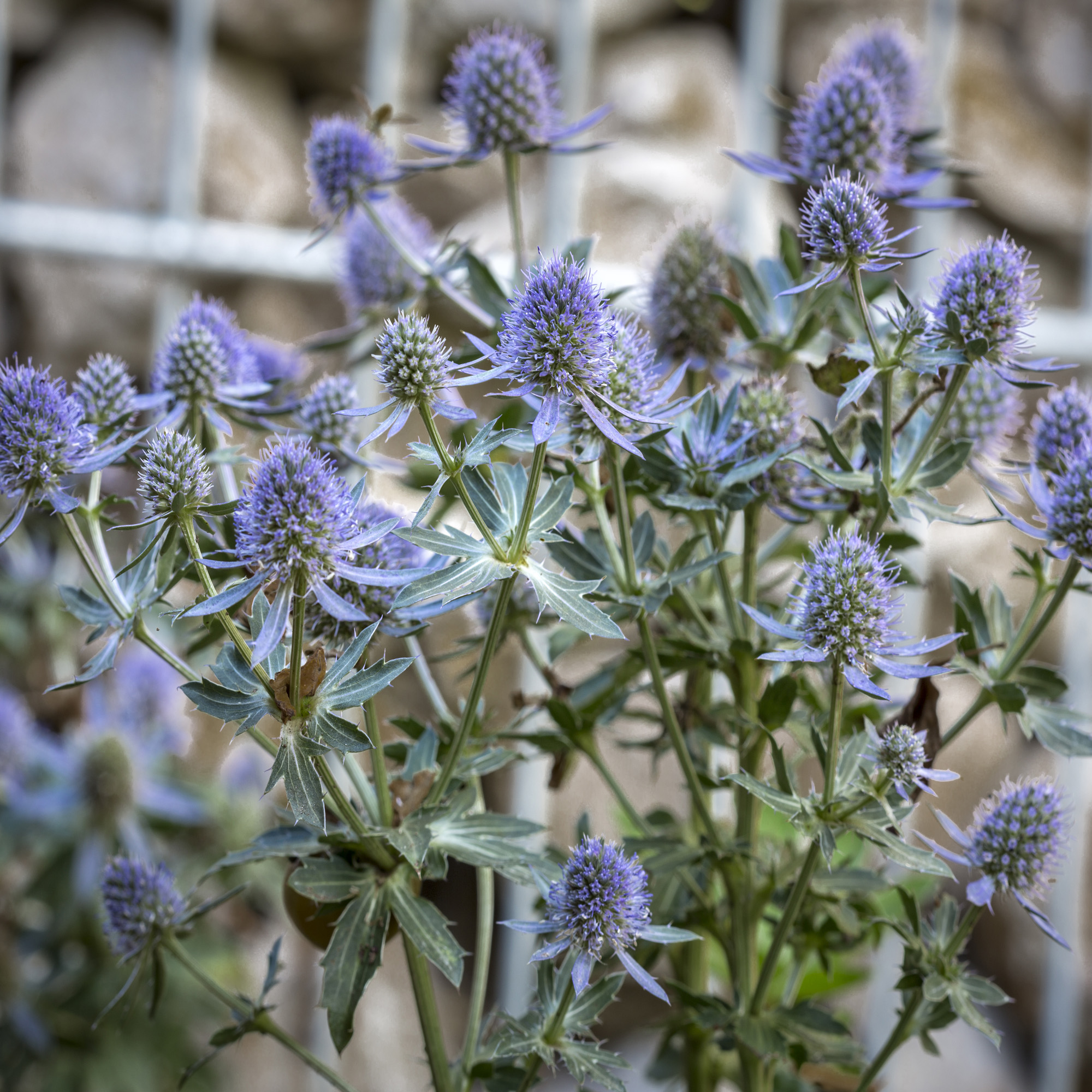
SF330 Blue Sea Holly ( Eryngium planum )
Unique and stately, Eryngium Planum, commonly called Sea Holly, has been grown from flower seeds in America since the 1800's. Almost all Eryngium make excellent cut flowers as well as flowers used for drying. The flowers keep their beautiful blue color after drying indoors. Harvest flowers when the entire flower heads and bracts turn blue.
Sea Holly self-sows readily by dropping its flower seeds on the ground, but it is not invasive. If the Sea Holly seeds are started indoors, transplant the seedlings where you want them to grow when they are quite small. The Eryngium plants have taproots, so they won't transplant well once mature. Sea Holly plants attract bees and butterflies, and they are a great plant for a low water garden. Eryngium seeds can be started directly outside in the spring after frost season has passed. Grows about 48" tall, a perennial for zones 4-9.
Sea Holly self-sows readily by dropping its flower seeds on the ground, but it is not invasive. If the Sea Holly seeds are started indoors, transplant the seedlings where you want them to grow when they are quite small. The Eryngium plants have taproots, so they won't transplant well once mature. Sea Holly plants attract bees and butterflies, and they are a great plant for a low water garden. Eryngium seeds can be started directly outside in the spring after frost season has passed. Grows about 48" tall, a perennial for zones 4-9.
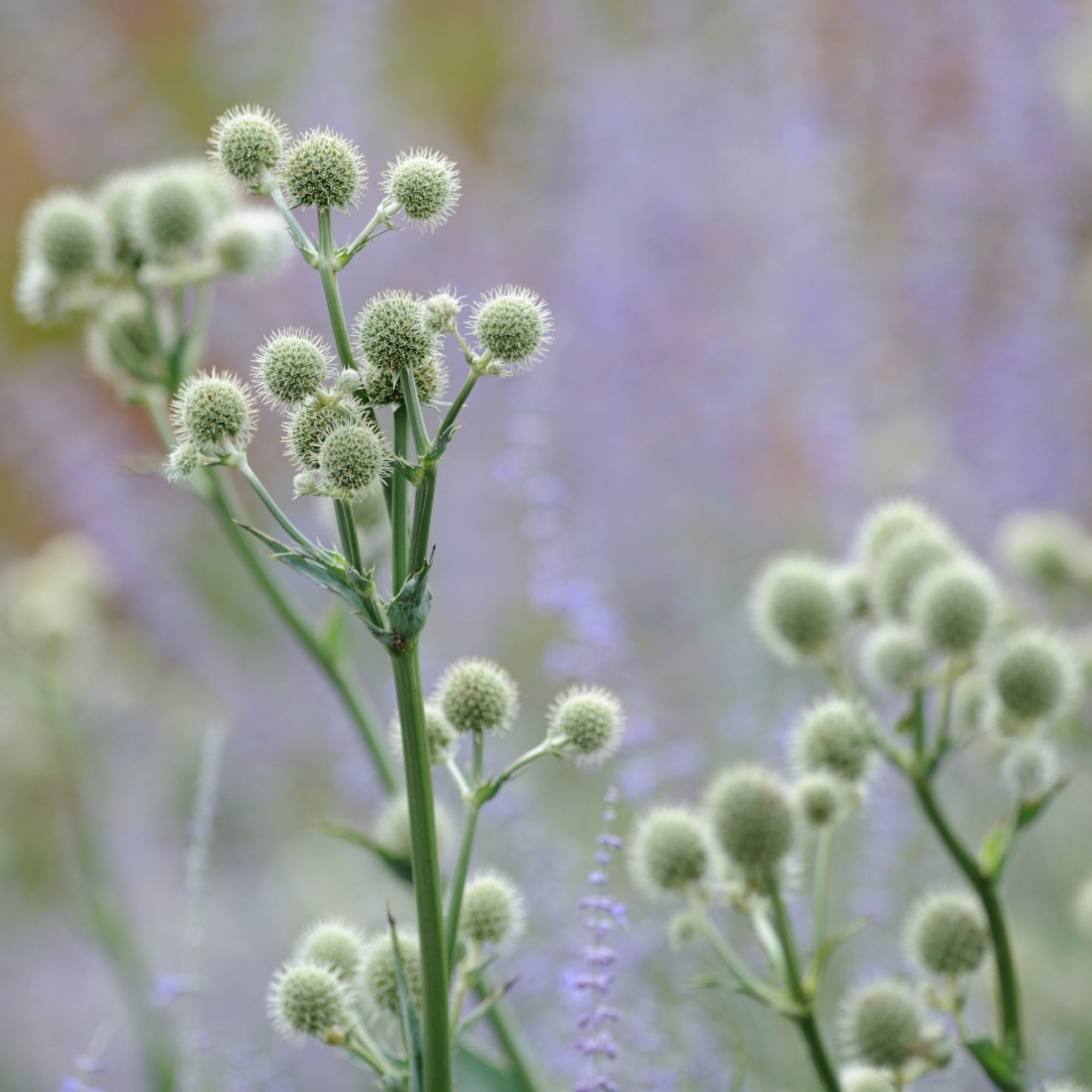
LET982 Rattlesnake Master ( Eryngium yuccifolium )
A very nice plant to match with Blue Sea Holly in cutflower arrangements. Rattlesnake master is a native prairie plant primarily known for attracting a wide variety of pollinators, including bees, butterflies, wasps, and other beneficial insects, and also has some historical medicinal uses.
The plant's white, spherical flower heads are rich in nectar and pollen, making them highly attractive to various pollinators. It is a magnet for bees and butterflies.
Native Americans used the plant's sap and roots for various medicinal purposes, including treating snakebites, venereal diseases, impotence, and expelling worms.
The plant's common name, "rattlesnake master," stems from the misconception that it could be used as an antidote for rattlesnake venom. Grows about 48" tall, a perennial for zones 4-9.
The plant's white, spherical flower heads are rich in nectar and pollen, making them highly attractive to various pollinators. It is a magnet for bees and butterflies.
Native Americans used the plant's sap and roots for various medicinal purposes, including treating snakebites, venereal diseases, impotence, and expelling worms.
The plant's common name, "rattlesnake master," stems from the misconception that it could be used as an antidote for rattlesnake venom. Grows about 48" tall, a perennial for zones 4-9.
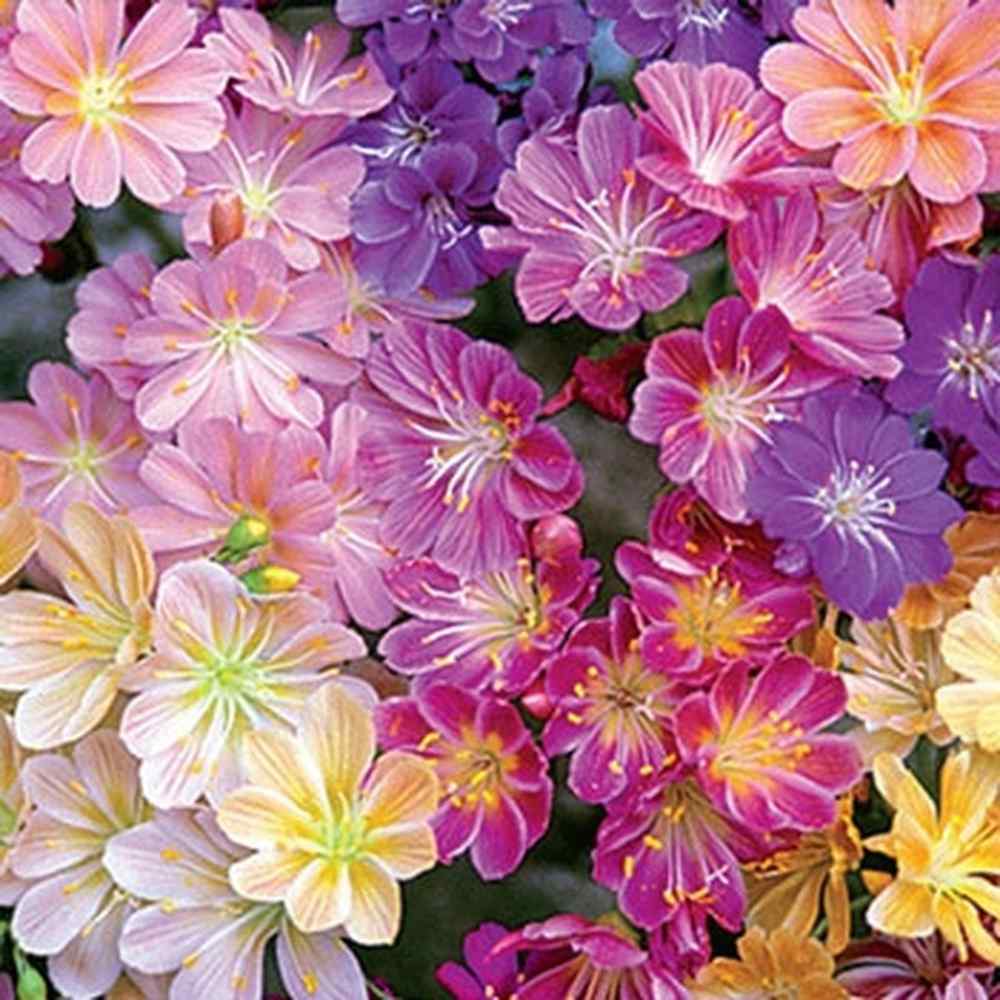
JB277 Rainbow Mix Lewisia ( Lewisia Hybrid Mix )
Lewisia Rainbow Hybrids mix will grow approximately 10 inches tall from flower seeds. This award winning mix features many colors and forms, the widest color range in Lewisia to date. Round, wide, petalled flowers include some semi-doubles. Colors range white, yellow, pink, red/orange, blue/red. Use this wonderful Lewisia plant for borders, perennial containers, rockeries, and xeriscape gardening. Lewisia will typically begin blooming in May and continue to put on a display of flower clusters clear in to early Fall.
These blooming clusters grown from flower seeds are held atop sturdy 8 - 12 inch stems of the Lewisia plant. These larger flowers are held in radiating clusters above an attractive succulent five inch green rosette that develops into a considerable mound with time. Lewisia plants are deeply tap-rooted so they do not require a lot of water. Lewisia benefits from some dryness, so all you have to do is plant the flower seeds in a clay pot with some gravel added or stick them in the cracks of a rock wall or enjoy them in a well-drained rock garden. Perennial for zones 4-9.
These blooming clusters grown from flower seeds are held atop sturdy 8 - 12 inch stems of the Lewisia plant. These larger flowers are held in radiating clusters above an attractive succulent five inch green rosette that develops into a considerable mound with time. Lewisia plants are deeply tap-rooted so they do not require a lot of water. Lewisia benefits from some dryness, so all you have to do is plant the flower seeds in a clay pot with some gravel added or stick them in the cracks of a rock wall or enjoy them in a well-drained rock garden. Perennial for zones 4-9.
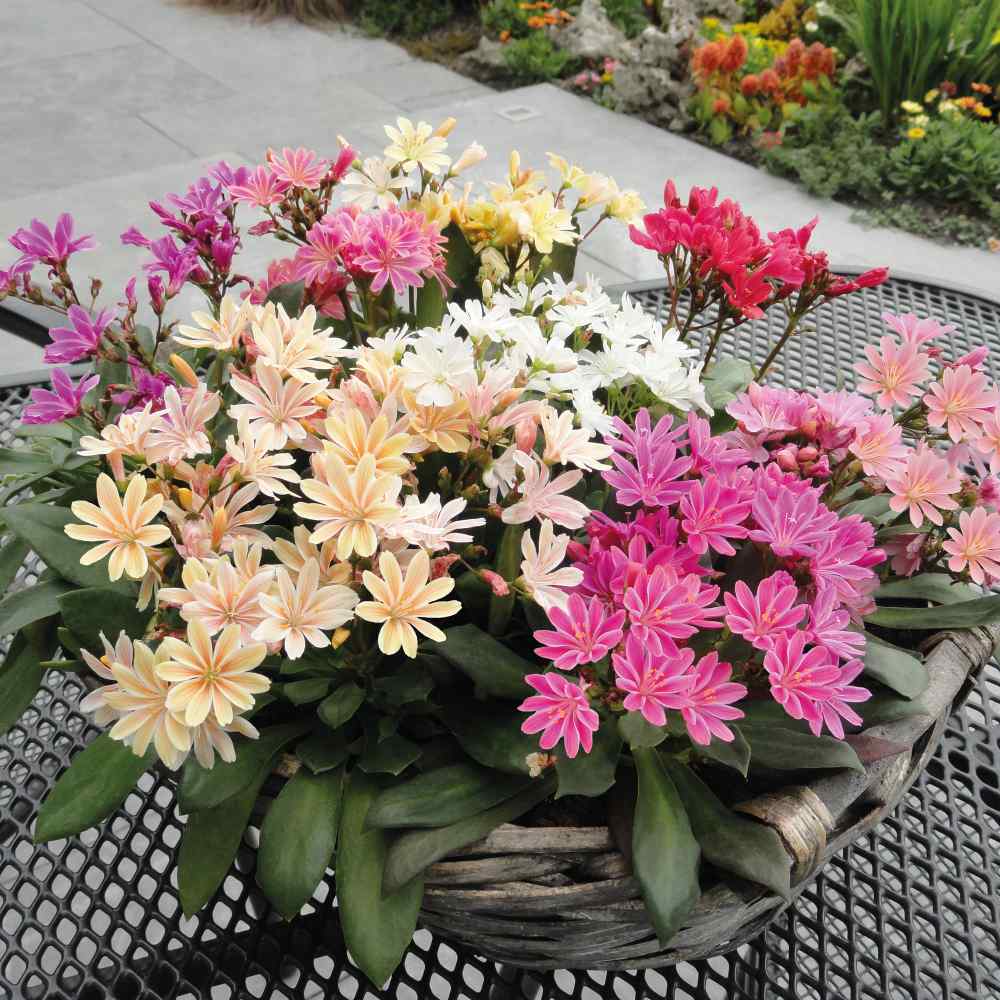
LET712 Elsie Mix Lewisia ( Lewisia Elsie Mix )
If you have an alpine or rock garden, Lewisia seeds are a great addition and will provide continued color from May through the fall. The Lewisia Elise mix includes shades of purple, coral, pink, yellow, and white with many bicolor markings. Lewisia plants are succulents and are very drought tolerant. Lewisia cotyledon is an evergreen plant. It grows from a rosette with long, wavy, succulent leaves, and the flowers form on stems that rise up from the rosette. The Lewisia flowers are solids or striped and provide wonderful beauty in the sunny landscape setting. This species is commonly known as Siskiyou Lewisia. Lewisia care includes providing sharply draining, deep soil. Provide good air-circulation to prevent any fungal diseases. Grows 8-12 inches tall. Perennial for zones 4-9.

LET714 Sunset Strain Lewisia ( Lewisia )
I One of the prettiest flowers you will find, this perennial flowering plant is also extremely hardy, long blooming and low maintenance. This above image from perennials.com illustrates how beautiful this flower is. Lewisia will typically begin blooming in May and continue to put on a display of flower clusters clear in to early Fall. Flower colors range from apricot, light pink, dark pink, pale tangerine, and light yellow.
These blooming clusters are held atop sturdy six inch stems of the Lewisia plant. The one inch flowers are held in radiating clusters above an attractive succulent five inch green rosette that develops into a considerable mound with time. Lewisia plants are deeply tap-rooted so they do not require a lot of water. Lewisia benefits from some dryness, so all you have to do is plant them in a clay pot with some gravel added or stick them in the cracks of a rock wall or enjoy them in a well-drained rock garden. Perennial for zones 4-9.
These blooming clusters are held atop sturdy six inch stems of the Lewisia plant. The one inch flowers are held in radiating clusters above an attractive succulent five inch green rosette that develops into a considerable mound with time. Lewisia plants are deeply tap-rooted so they do not require a lot of water. Lewisia benefits from some dryness, so all you have to do is plant them in a clay pot with some gravel added or stick them in the cracks of a rock wall or enjoy them in a well-drained rock garden. Perennial for zones 4-9.
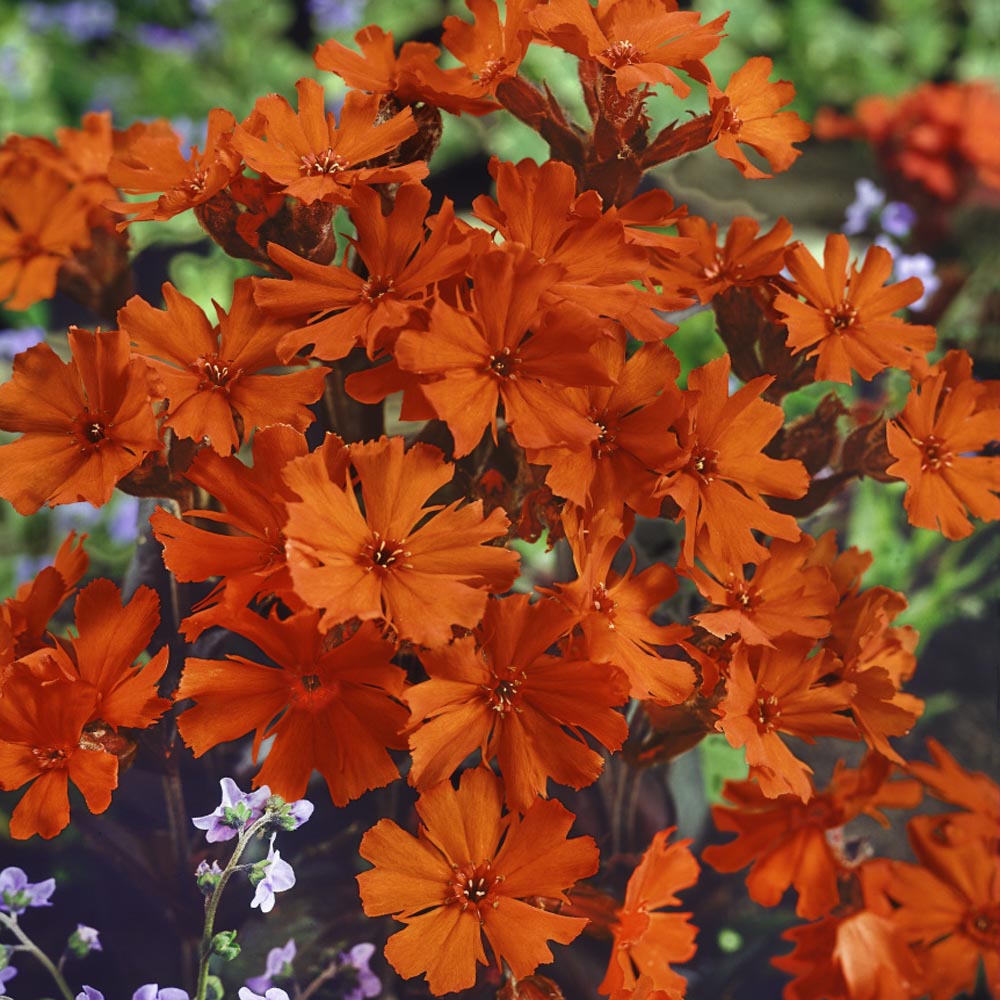
LET719 Vesuvius Lychnis ( Lychnis Arkwrightii )
Grow this attractive plant and have both gorgeous orange-red blooms and purple colored foliage. The combination is striking! This flowering Lychnis plant commands attention when it's in bloom during the summer months, and hummingbirds cannot stay away from the brightly colored flowers! Commonly, this perennial is called Arkwright's Campion.
This Arkwright's Campion plant grows 16 - 20 inches tall, with erect stems and is hardy in zones 3 - 10 in normal environmental conditions. Arkwright's Campion flowers are a brilliant orange-scarlet color like molten lava flowing from the volcano, Mt. Vesuvius (hence the name), and they are simple in form with 5 deeply notched petals measuring 1 1/4 - 2 inches across.
Sow Lychnis seeds indoors 6 - 8 weeks before the last frost is expected. Use well-draining starter soil. Sow the Lychnis seeds on the surface, lightly covered. Keep seed continuously moist until germination. Some gardeners will cover with plastic wrap to keep humidity high. Transplant outdoors after danger of frost. Lychnis care includes watering deeply throughout the growing season, mulching around the base to keep the roots cool, and deadheading spent blooms to prolong the blooming season. Let the last blooms go to seed so that Lychnis can re-seed itself. If re-seeding is not desired, cut the stems back down to basal growth after blooming. Perennial for zones 3-10.
This Arkwright's Campion plant grows 16 - 20 inches tall, with erect stems and is hardy in zones 3 - 10 in normal environmental conditions. Arkwright's Campion flowers are a brilliant orange-scarlet color like molten lava flowing from the volcano, Mt. Vesuvius (hence the name), and they are simple in form with 5 deeply notched petals measuring 1 1/4 - 2 inches across.
Sow Lychnis seeds indoors 6 - 8 weeks before the last frost is expected. Use well-draining starter soil. Sow the Lychnis seeds on the surface, lightly covered. Keep seed continuously moist until germination. Some gardeners will cover with plastic wrap to keep humidity high. Transplant outdoors after danger of frost. Lychnis care includes watering deeply throughout the growing season, mulching around the base to keep the roots cool, and deadheading spent blooms to prolong the blooming season. Let the last blooms go to seed so that Lychnis can re-seed itself. If re-seeding is not desired, cut the stems back down to basal growth after blooming. Perennial for zones 3-10.
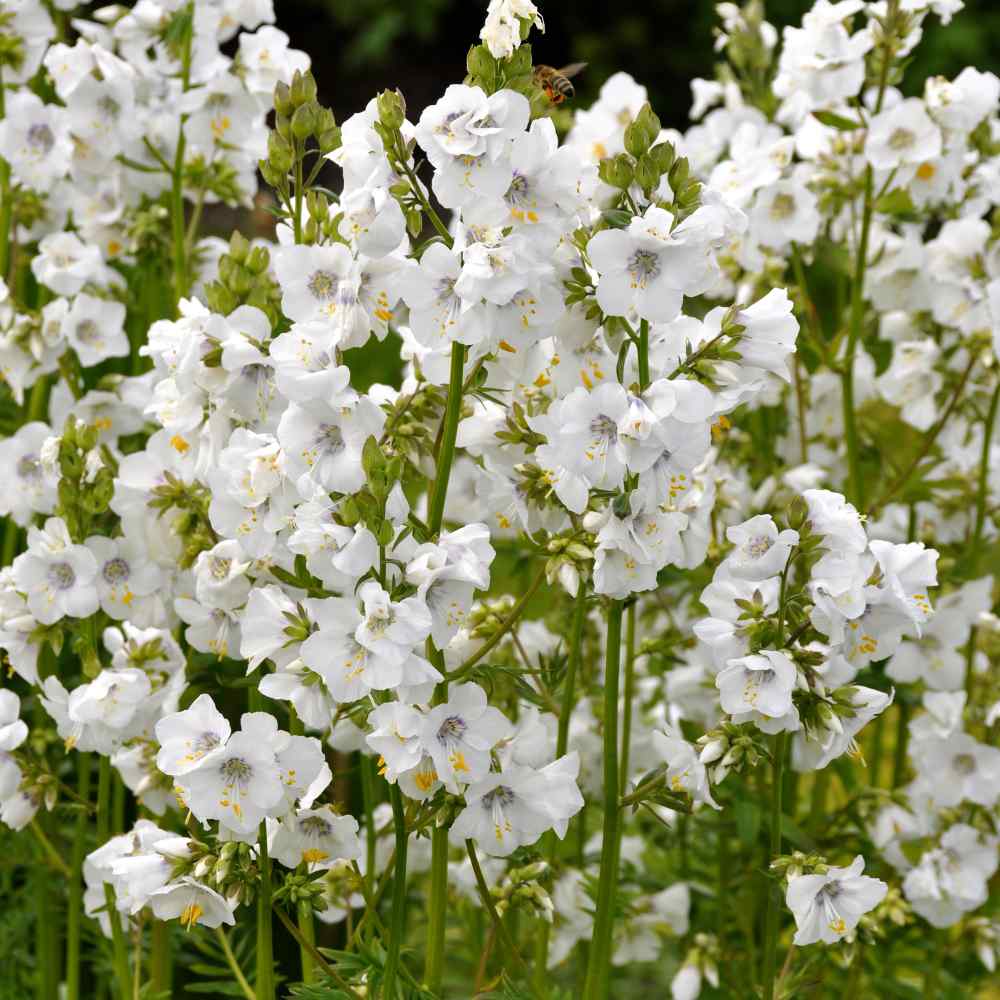
LET762 White Jacobs Ladder ( Polemonium Caeruleum White )
This perennial is a cottage garden favorite grown from Polemonium seeds. It is also known as white Jacob's Ladder, and it is a hardy herb that was used for medicinal purposes for centuries. It is a very attractive plant for a border or bed with moist but well-drained soil. The leaves give the plant its name as they are divided like ladder rungs, and the blooms are cup-shaped and white. White Jacob's Ladder plants are native to Europe growing in damp grasslands, woodlands, meadows and rocky areas. Polemonium Caeruleum Jacob's Ladder usually reaches a height of 28 inches, but occasionally will grow taller. Many people believe the Jacob's Ladder herb can be used as a remedy for several common health ailments, and the herb seeds are grown for medicinal use. A perennial for zones 3-8.
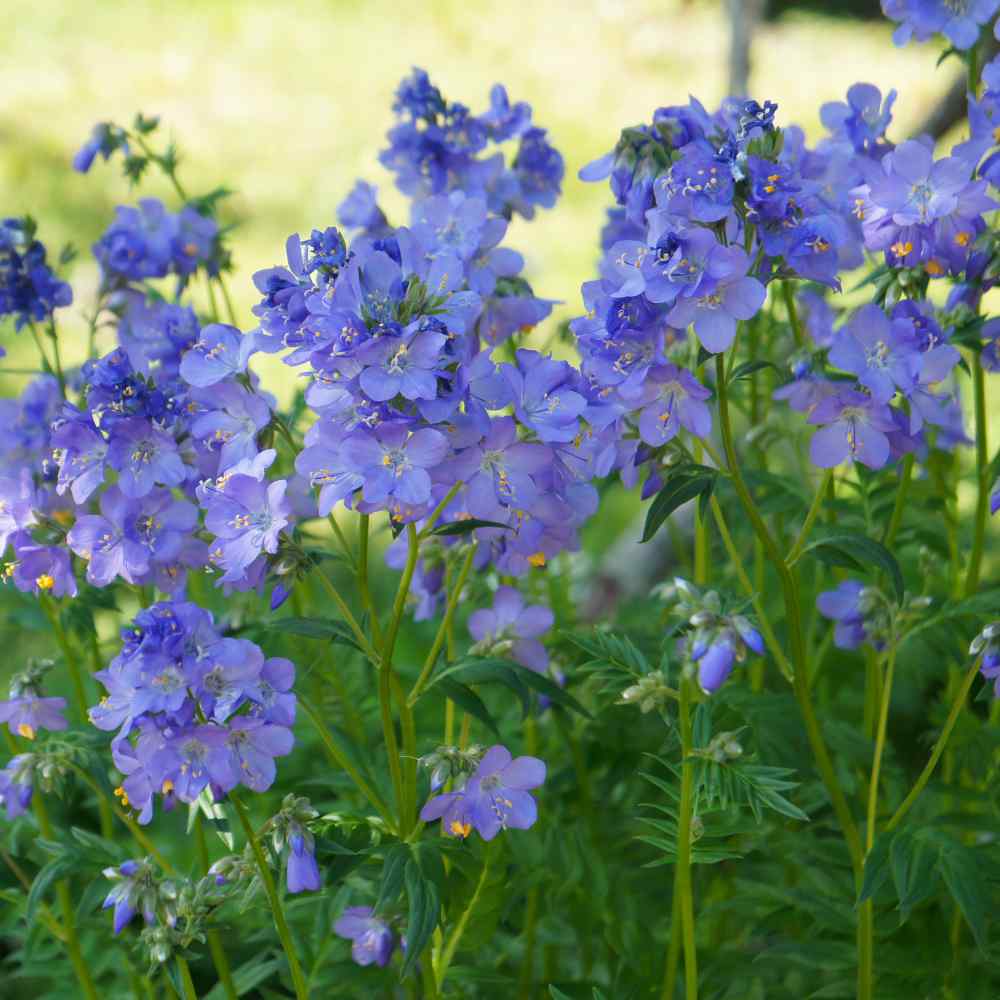
LET763 Blue Jacobs Ladder ( Polemonium Caeruleum White )
his perennial flower can be grown from Polemonium seeds and has the common name of Jacob's Ladder. The name was inspired by the leaves on the plant which are in successive pairs opposite each other resembling a ladder. It has attractive fern-like foliage that is arched and creates dense mounds from which blue flower spikes protrude upwards. The Jacob's Ladder flowers are in clusters and are bell-shaped in various shades of blue with contrasting bright yellow stamens. Very striking!
Jacob's Ladder requires good soil drainage as well as full sun to partial shade. The foliage blends well with hostas, bleeding hearts and lilies. Many people believe that the Jacob's Ladder herb can be used for a remedy for headaches, nervousness, and heart irregularities. More research is needed in this area. A perennial for zones 3-8.
Jacob's Ladder requires good soil drainage as well as full sun to partial shade. The foliage blends well with hostas, bleeding hearts and lilies. Many people believe that the Jacob's Ladder herb can be used for a remedy for headaches, nervousness, and heart irregularities. More research is needed in this area. A perennial for zones 3-8.
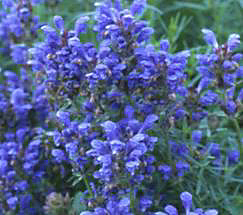
SF037 Blue Moon Dragon's Head ( Dracocephalum )
A beautiful perennial plant with violet-blue flowers in erect
spikes and delightfully scented foliage growing to 12 inches
tall.
Color: Violet Blue Zone: 4-8 Spacing:18" Height: 12" Start Seeds: Anytime of year inside, for transplanting outside in Spring.
Color: Violet Blue Zone: 4-8 Spacing:18" Height: 12" Start Seeds: Anytime of year inside, for transplanting outside in Spring.
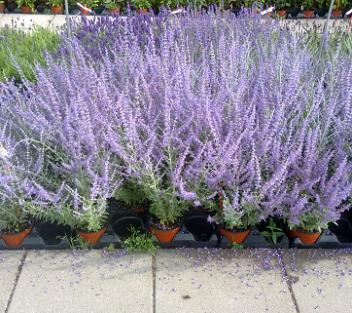
JB091 Blue Steel ( Perovskia atriplicifolia )
Shorter, bulkier version of Taiga, this perovskia's Silvery green foliage contrasts w/tiny blue flowers. Also known as Russian Sage, this is a perennial staple, and now there are seed produced varieties! Sky blue flower spikes beautifully set off slivery green foliage. Hardy in zone 5 and higher, Russian Sage is both heat and drought tolerant, perfect for landscaping and accent plants! Perennial zone 5-9.
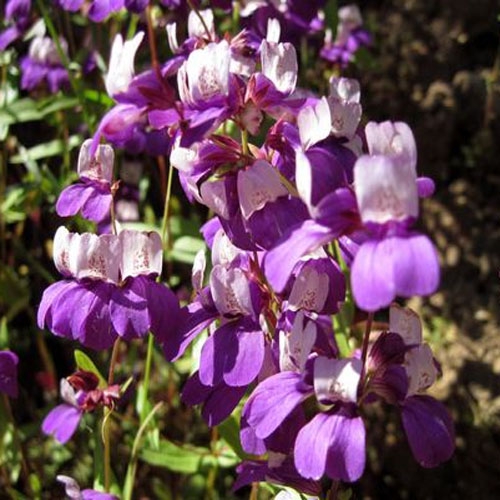
SF324 Chinese Houses ( Collinsia heterophylla )
Snapdragon-like flowers in tiers resembling pagodas give this lavender-white West Coast American native its name. Great for cutting. A charming wildflower that is not as well known as it should be. A native of California, it produces lovely purple and white spires, one stacked on top of the other. Chinese Houses seeds are quite easy to establish, and can be planted in both sun or shade.
The Chinese Houses plant is a good choice for a wild life or butterfly garden as the Checkerspot Butterfly will use it as a host plant for its larva. An annual for almost all zones. Grows about 12 inches tall.
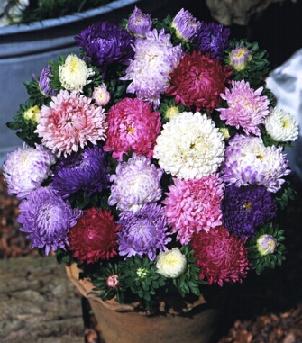
3001 Duchesse Mix ( Aster )
You cannot go wrong with this incredible mix of colors! This Aster seed mix offers colors of yellow, scarlet, apricot, dark blue and more. Duchess Asters have huge, double blooms with incurved petals that grow on tall, upright plants with 5 to 8 floral stems. Aster Callistephus is an excellent cutting flower and has a long vase-life. Their flowers are similar to autumn chrysanthemums, but they bloom so much earlier in the season. Annual.

